牛津英语上海版教材.
- 格式:ppt
- 大小:84.50 KB
- 文档页数:10
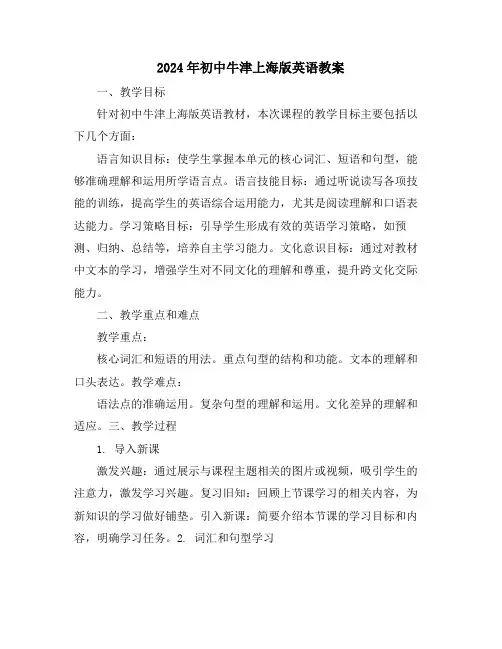
2024年初中牛津上海版英语教案一、教学目标针对初中牛津上海版英语教材,本次课程的教学目标主要包括以下几个方面:语言知识目标:使学生掌握本单元的核心词汇、短语和句型,能够准确理解和运用所学语言点。
语言技能目标:通过听说读写各项技能的训练,提高学生的英语综合运用能力,尤其是阅读理解和口语表达能力。
学习策略目标:引导学生形成有效的英语学习策略,如预测、归纳、总结等,培养自主学习能力。
文化意识目标:通过对教材中文本的学习,增强学生对不同文化的理解和尊重,提升跨文化交际能力。
二、教学重点和难点教学重点:核心词汇和短语的用法。
重点句型的结构和功能。
文本的理解和口头表达。
教学难点:语法点的准确运用。
复杂句型的理解和运用。
文化差异的理解和适应。
三、教学过程1. 导入新课激发兴趣:通过展示与课程主题相关的图片或视频,吸引学生的注意力,激发学习兴趣。
复习旧知:回顾上节课学习的相关内容,为新知识的学习做好铺垫。
引入新课:简要介绍本节课的学习目标和内容,明确学习任务。
2. 词汇和句型学习呈现新词汇:通过实物、图片或多媒体等方式呈现新词汇,帮助学生直观理解。
讲解词汇用法:详细解释新词汇的用法,包括词性、搭配等,并给出例句。
句型操练:通过替换、填空等方式,让学生操练重点句型,加深对句型的理解。
3. 文本理解和口头表达阅读文本:指导学生阅读教材文本,注意理解文本中的重点信息和语言点。
小组讨论:组织学生进行小组讨论,就文本内容展开讨论,培养口语表达能力。
汇报交流:每个小组选派代表汇报讨论成果,其他同学进行点评和补充。
4. 语法点讲解和练习呈现语法点:明确本节课的语法点,通过例句展示其用法。
讲解语法规则:详细解释语法点的构成和用法,帮助学生理解。
语法练习:设计多种形式的练习,如填空、选择、改写等,让学生充分练习。
5. 文化差异理解和适应对比文化:通过对比中英文化中的相似点和差异点,帮助学生理解文化差异。
讨论交流:组织学生就文化差异进行讨论交流,分享自己的见解和体验。
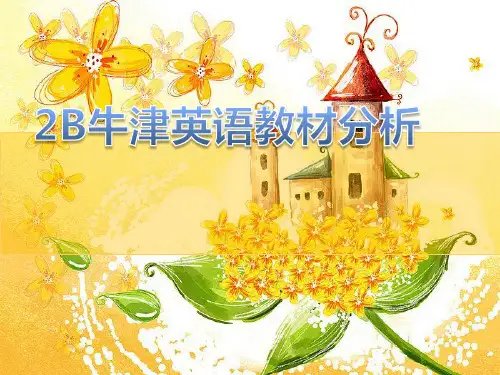
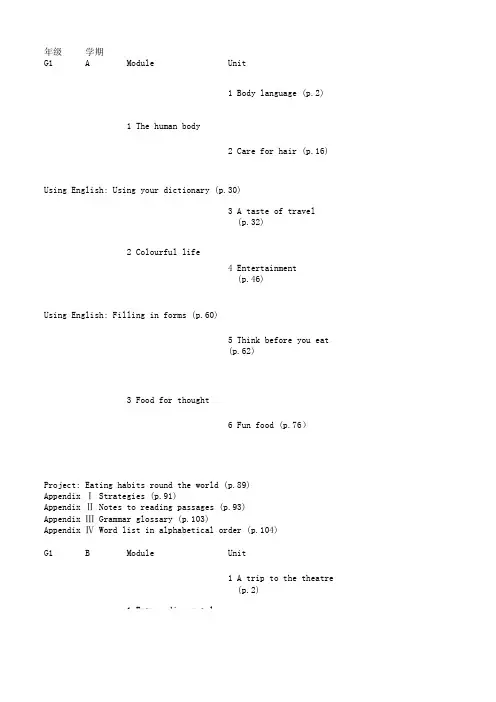
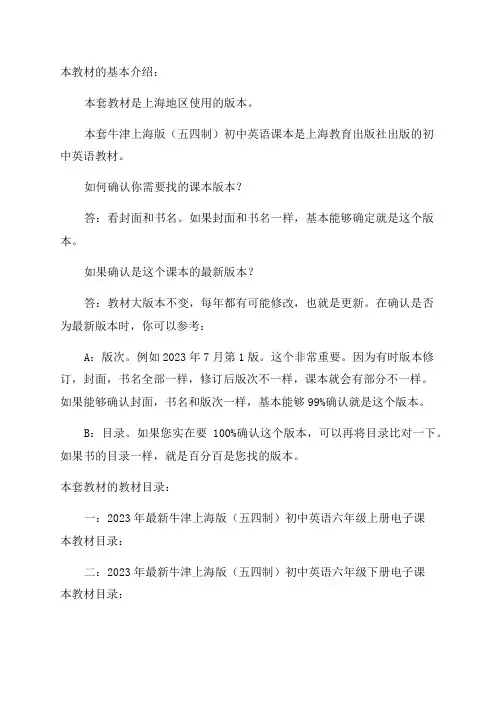
本教材的基本介绍:本套教材是上海地区使用的版本。
本套牛津上海版(五四制)初中英语课本是上海教育出版社出版的初中英语教材。
如何确认你需要找的课本版本?答:看封面和书名。
如果封面和书名一样,基本能够确定就是这个版本。
如果确认是这个课本的最新版本?答:教材大版本不变,每年都有可能修改,也就是更新。
在确认是否为最新版本时,你可以参考:A:版次。
例如2023年7月第1版。
这个非常重要。
因为有时版本修订,封面,书名全部一样,修订后版次不一样,课本就会有部分不一样。
如果能够确认封面,书名和版次一样,基本能够99%确认就是这个版本。
B:目录。
如果您实在要100%确认这个版本,可以再将目录比对一下。
如果书的目录一样,就是百分百是您找的版本。
本套教材的教材目录:一:2023年最新牛津上海版(五四制)初中英语六年级上册电子课本教材目录:二:2023年最新牛津上海版(五四制)初中英语六年级下册电子课本教材目录:三:2023年最新牛津上海版(五四制)初中英语七年级上册电子课本教材目录:四:2023年最新牛津上海版(五四制)初中英语七年级下册电子课本教材目录:五:2023年最新牛津上海版(五四制)初中英语八年级上册电子课本教材目录:六:2023年最新牛津上海版(五四制)初中英语八年级下册电子课本教材目录:七:2023年最新牛津上海版(五四制)初中英语九年级上册电子课本教材目录:八:2023年最新牛津上海版(五四制)初中英语九年级下册电子课本教材目录:教辅学习与选择指南:在学习新课的时候,我们首先要使用的是全解类教辅或者解读类的教辅,对于教材中需要掌握的知识点有非常详细的讲解和总结,方便家长辅导,也方便学生自学。
完成了知识点的学习后,必要的课本配套练习也是必不可少的,这个时候可以使用课时练习类教辅,例如课课练、天天练、一课一练、配套练习册等。
在完成了一个阶段的学习后,就需要通过测试检验一下学习效果,这时就该轮到单元类或者结合类试卷类教辅上场了,包括了有周考卷、月考卷、单元卷、专题卷以及期中期末卷,能够让学生通过测试卷检验每一个阶段的学习效果。
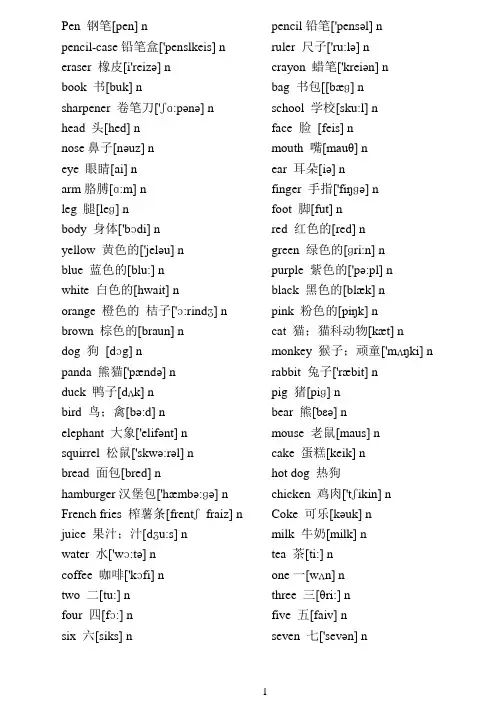
Pen 钢笔[pen] n pencil铅笔['pensəl] npencil-case铅笔盒['penslkeis] n ruler 尺子['ru:lə] neraser 橡皮[i'reizə] n crayon 蜡笔['kreiən] nbook 书[buk] n bag 书包[[bæɡ] nsharpener 卷笔刀['ʃɑ:pənə] n school 学校[sku:l] nhead 头[hed] n face 脸[feis] nnose鼻子[nəuz] n mouth 嘴[mauθ] neye 眼睛[ai] n ear 耳朵[iə] narm胳膊[ɑ:m] n finger 手指['fiŋɡə] nleg 腿[leɡ] n foot 脚[fut] nbody 身体['bɔdi] n red 红色的[red] nyellow 黄色的['jeləu] n green 绿色的[ɡri:n] nblue 蓝色的[blu:] n purple 紫色的['pə:pl] nwhite 白色的[hwait] n black 黑色的[blæk] n orange 橙色的桔子['ɔ:rindʒ] n pink 粉色的[piŋk] nbrown 棕色的[braun] n cat 猫;猫科动物[kæt] ndog 狗[dɔg] n monkey 猴子;顽童['mʌŋki] n panda 熊猫['pændə] n rabbit 兔子['ræbit] nduck 鸭子[dʌk] n pig 猪[piɡ] nbird 鸟;禽[bə:d] n bear 熊[bεə] nelephant 大象['elifənt] n mouse 老鼠[maus] nsquirrel 松鼠['skwə:rəl] n cake 蛋糕[keik] nbread 面包[bred] n hot dog 热狗hamburger汉堡包['hæmbə:ɡə] n chicken 鸡肉['tʃikin] n French fries 榨薯条[frentʃfraiz] n Coke 可乐[kəuk] njuice 果汁;汁[dʒu:s] n milk 牛奶[milk] nwater 水['wɔ:tə] n tea 茶[ti:] ncoffee 咖啡['kɔfi] n one一[wʌn] ntwo 二[tu:] n three 三[θri:] nfour 四[fɔ:] n five 五[faiv] nsix 六[siks] n seven 七['sevən] neight 八[eit] n nine 九[nain] nten 十[ten] n doll 玩具娃娃[dɔl] nballoon 气球[bə'lu:n] n car 小汽车[kɑ:] nplane 飞机[plein] n text 课文;文本[tekst] nself 自己;自我;本质[self] n word 单词;言辞;歌词[wə:d] n type 类型;样式;榜样[taip] n module 单元;组件['mɔdju:l] n daily 每日的;日常的['deili] a grammar语法['græmə] n content (书刊等的)目录;内容[kən'tent] n love 爱[lʌv] n expression 表达;表现力;表情[iks'preʃən] n wall 墙[wɔ:l] n project 方案;计划[prə'dʒekt] n dictionary 字典['dikʃəneri] n sheet 印刷品;表格[ʃi:t] n mum 妈妈(口语)[mʌm] n vocabulary 词汇;用词范围;词典[və'kæbjuləri] npoem (一首)诗['pəuim] n page 页[peidʒ] noral 口试['ɔ:rəl] n unit 单元;单位['ju:nit] nI am (我)是[æm] you 你[ju:] pronare (你)是[ɑ:] v come in. 进来['kʌm in]name 名字[neim] n class 班[klɑ:s ] ngood 好的[ɡud] n good morning! 早上好new新的;新闻[nju:] n we 我们[wi:] pronfrom 从……[frɔm] prep from beijing 从北京来的chair 椅子[tʃɛə] n floor 地板[flɔ:] nbox 盒子[bɔks] n at 在...;在……时[æt] prep zoo 动物园[zu:] n at the zoo 在动物园里park 公园[pɑ:k] n classroom 教室['klɑ:srum] n factory工厂['fæktəri] n square 广场[skwεə] ncapital首都['kæpitəl] n China 中国['tʃaɪnə] nthe capital of China 中国首都motherland 祖国['mʌðəlænd] n has有[hæz] (have的第三人称单数现在式)cap 帽子[kæp] n star 星;星号;星状物[stɑ:] n our我们的['auə] pronnational国家的['næʃənəl] n national flag国旗[flæɡ]coat上衣[kəut] n have有[hæv] vlong长的[lɔŋ] a short短的;矮的[ʃɔ:t] abig大的[biɡ] a small小的[smɔ:l] aor或;还是[ɔ:] conj guess 猜[ɡes] nhey 嗨[hei] int tall高的[tɔ:l] aold年老的[əuld] a young年轻的[jʌŋ] aChinese 中国的;汉语;中国人['tʃai'ni:z] over 越(过) ['əuvə] vEnglish英国的;英语;英国人['iŋgliʃ] there 那儿[ðεə] adover there 在那边join 参加[dʒɔin] nother另外的['ʌðə] pron an一(个) [æn] artapple苹果['æpl] n hand手[hænd] negg蛋[eɡ] n them 他(她;它)们(宾格) [ðem] pron umbrella 伞[ʌm'brelə] n school is over. 放学了home家[həum] n go home 回家rain 雨;下雨[rein] n it's raining. 正在下雨can't 不能[kɑ:nt] now 现在[nau] admuch许多;很;非常[mʌtʃ] a ad how much 多少eleven 十一[i'levən] num twelve十二[twelv] numminus 减['mainəs] prep a n here这儿[hiə] ad nHere you are. 给你money 钱;收入['mʌni] nthey 他(她;它)们[ðei] pron twenty 二十;二十年代['twenti] num these 这些[ði:z] pron door 门;出口[dɔ:] nwindow窗['windəu] n picture图画;照片['piktʃə] ntalk说话;谈论;演讲[tɔ:k] n about 关于[ə'baut] prepflower花;开花;精华['flauə] n some 一些[sʌm] pronboat 船;小船[bəut] n lake 湖[leik] nskirt 裙子;边缘;外围[skə:t] n clean 清洁的[kli:n] ashirt (男式)衬衫[ʃə:t] n dirty脏的['də:ti] acup 杯子;奖杯[kʌp] n glass玻璃杯[ɡlɑ:s] npicture-book 图画书have a look 看一看sure 当然;一定;可靠地[ʃuə] a ad and和[ænd] conjtheir 他(她;它)们的[ðεə] pron pioneer 先锋[,paiə'niə] nright对的[rait] a n young pioneer 少年先锋队员scarf 领巾[skɑ:f] n red scarf 红领巾all全部;都;尽可能的[ɔ:l] ad pron n both 两[bəuθ] pron peasant农民['pezənt] n soldier士兵;兵蚁['səuldʒə] n doctor医生;博士['dɔktə] n class is over下课了play 玩;演奏;表演[plei] v n there are 有what are they doing? 她们在做什么?do做[du:] v pingpong 乒乓球;桌球['piŋpɔŋ] n rainbow 彩虹['reinbəu] n American美国的,美国人[ə'merikən] Paper 纸;报纸;报告['peipə] n piece片[pi:s] n a piece of 一片;一张ink墨水[iŋk] n bottle瓶;酒['bɔtl] na bottle of 一瓶me我(宾格) [mi:] pronplease请[pli:z] v thank谢谢[θæŋk] v nwant要;想见;追捕[wɔnt] v write写[rait] vletter信['letə] n any任何['eni] pronThanks谢谢way路;路程[wei] ngo去[ɡəu] v go to the door 到门那儿去open开;开阔的['əupən] v close关;结账[kləuz] v blackboard黑板['blækbɔ:d] n clean把…弄干净[kli:n] vfootball足球;橄榄球['futbɔ:l] n Match比赛;对手[mætʃ] n between在(两者)之间[bi'twi:n] prep this afternoon今天下午[,ɑ:ftə:'nu:n] time时候;次;时代[taim] n have you any paper? 你有纸吗?what time? 什么时候?at three 在三时;在三点but但是;而是;然而[bʌt] conj jacket外衣;夹克;皮['dʒækit] n basketball篮球['bæskitbɔ:l] n TV电视radio 收音机;电台['reidiəu] n bat球拍;击球[bæt] nmaybe也许;可能['meibi] ad of course 当然[kɔ:s]knife小刀;手术刀;匕首[naif] n sorry对不起;抱歉['sɔri] intfor为;代替;因为;为得到[ fɔ:] prep can能够;可以;究竟[kæn] v.aux make做;制作;作出举动[meik] v right now立刻there is有;存在near 靠近[niə] ad prepplayground操场['pleiɡraund] n model模型;模特;模范['mɔdl] n model plane模型飞机model ship 模型轮船sky天空;天气;顶峰[skai] n bright明亮的;开朗的[brait] a above 在…上方[ə'bʌv] prep lesson功课;课程;教训['lesən] v have lessons上课like喜欢;愿意;希望[laik] v Like 爱好[laik] n table桌子['teibl] nlet让;出租[let] v artist 画家;艺术家['ɑ:tist] n house房子[haus] n tree 树;家谱[tri:] nriver河流;巨量['rivə] n front前面;前部;正面[frʌnt] n in front of 在…前面then那么;然后[ðen] adtcow母牛[kau] n behind在..后面[bi'haind] prep goose鹅[ɡu:s] n geese鹅(复数) [ɡi:s]moon月亮;月光[mu:n] n air 空气;天空;气氛[εə] n mountain山;山脉['mauntin] n think想;认为[θiŋk] vso这样;这么;所以['səu] ad give给;生产;出售[ɡiv] v animal动物['æniməl] n life 生命;生活[laif] nwhich 哪一个[hwitʃ] adv nineteen十九[,nain'ti:n] num thirty 三十['θə:ti] num twenty-one二十一['twenti,wʌn] thirty-three三十三['θə:ti'θri:] miss 女士;小姐;少女[mis] n people 人;人民;民族['pi:pl] n family家;家庭;家族['fæmili] n day白天;时代;……节日[dei] n week周;星期[wi:k] ntoday今天[tə'dei] n baby婴儿;幼畜['beibi] nsee看见[si:] v zebra斑马;有斑纹的['zi:brə] n run跑;行驶;运行;逃跑[rʌn] n jump跳[dʒʌmp] vall the time 一直count数[kaunt] v nlion狮子;勇敢的人['laiən] n tiger 老虎;凶残的人['taiɡə] nsit坐[sit] v exercise练习;运动['eksəsaiz] v down向下[daun] prep ad very很;非常['veri] adexercise-book 练习本out出;在外[aut] adout of 向(在)…外面listen听['lisən] vread读;察觉[ri:d] v after在…后面['ɑ:ftə] prepstop停止[stɔp] v n wait 等待[weit] vevening傍晚;晚上['i:vniŋ] n cinema电影院['sinəmə] n crossing 十字路口['krɔ:siŋ] n light 灯;光;火花;眼神['lait] n must必须;应该[mʌst] v.aux. yet还(没有)…还(不)…[jet] ad conj o'clock 点钟[ə' klɔk] morning早晨;上午['mɔ:niŋ] nget得到[ɡet] n up向上;上升;在……上面[ʌp] n get up起床half半[hɑ:f] n adpast过[pɑ:st] v morning exercises早操breakfast早餐['brekfəst] n eye-exercises 眼保操have a lesson上课draw画[drɔ:] vclock钟[klɔk] n tell 告诉;吩咐[tel] nher 她(宾格) [hə:] pron stand站;站立[stænd] vask 问;提问[ɑ:sk] v question问题['kwestʃən] nwell健康的[wel] a answer 回答['ɑ:nsə] vtalk in English 用英语交谈help 帮助;治疗[help] vquarter四分之一;一刻['kwɔ:tə] n game游戏[ɡeim] nstudy学习;研究;学问['stʌdi] n supper晚饭;晚餐会['sʌpə] n watch看;观看[wɔtʃ] v afraid 害怕的[ə'freid] aMr.先生(mister的缩写) ['mistə] n son儿子;女婿[sʌn] ndaughter女儿;媳妇;妇女['dɔ:tə] n newspaper报纸['nju:s,peipə] nby 在…旁;靠近prep play with 玩…sweep扫[swi:p] v floor地板;地面;……层[flɔ:] n mop擦;抹;拖[mɔp] v ready准备好了['redi] a adstill 还;仍旧[stil] ad lunch午餐[lʌntʃ] nroom房间[ru:m] n look for 寻找hurry匆忙;赶紧['hʌri] v n hurry up! 快点!fox狐狸;狡猾的人[fɔks] n news消息;新闻[nju:z] ncome this way 往这边来away离……;外出[ə'wei]run away 跑掉giraffe 长颈鹿[dʒi'rɑ:f] nwhy (表吃惊;满意等)哎呀!为什么?[hwai] adv noise 噪声[nɔiz] n pineapple 菠萝;凤梨['pain,æpl] n lorry 卡车['lɔ:ri] nlime 酸橙;菩提树[laim] n lizard 蜥蜴['lizəd] nboard 写字板;牌子;伙食[bɔ:d] n computer 计算机[kəm'pju:tə] n teacher’s desk 讲台fan扇子;电扇;螺旋桨[fæn] n classmate同学['klɑ:smeit] n good idea好主意[ai'diə]all right好吧;好的seat座位[si:t] ngood job 干的好[dʒɔb] what什么;(感叹)多少[hwɔt] pron int look at 看……Chinese book 语文书fat胖的;厚的;大量的[fæt] a heavy重的;沉重的['hevi] amay可以[mei] v.aux. long hair 长头发[hεə]short hair 短头发thin 瘦的;细的;薄的[θin] a strong 健壮的;坚固的[strɔŋ] a quiet 安静的['kwaiət] ahis 他的[hiz] pron photo 照片['fəutəu] nteacher 教师['ti:tʃə] n Student(大中学)学生['stju:dənt] n music音乐['mju:zik] n science科学;技术['saiəns] nsports 体育运动[spɔ:ts] n computer game电脑游戏painting 绘画;上油漆['peintiŋ] v boy 男孩;儿子;小儿子[bɔi] ngirl女孩;女儿[ɡə:l] n bathroom 卫生间;浴室['bæθrum] n bedroom 卧室['bedrum] n kitchen 厨房['kitʃin] nfridge 冰箱[fridʒ] n key钥匙[ki:] nrice米饭[rais] n noodle(s) 面条(通常复数)['nu:dl] n hungry饥饿的['hʌŋgri] a chopsticks筷子(复数)['tʃɔpstik] n horse 马[hɔ:s] n spoon 勺子[spu:n] nplate 盘子[pleit] n fork 叉子;岔口[fɔ:k] npass 传递;经过;度过[pɑ:s] v Try试;试一下[trai] vHelp yourself 随便吃show 展示;演出[ʃəu] nfood 食物[fu:d] n parents 父母['pєərənts] nuncle 叔叔舅舅姨夫姑父['ʌŋkl] n aunt 姑姑;婶;姨[ɑ:nt] nmember 成员['membə] n only 只有;仅仅['əunli] apuppy 小狗['pʌpi] n sister 姐妹['sistə] nfarmer 农民['fɑ:mə] n nurse 护士[nə:s] nit 它[it] pron class 课程[klɑ:s] ndress 连衣裙[dres] n T-shirt T恤衫no 不;不是[nəu] ad not 不;不是的[nɔt] adwarm 暖和的[wɔ:m] a cold 寒冷的[kəuld] acool 凉爽的[ku:l] a jean 牛仔裤;斜纹棉布[dʒi:n] n pant 长裤[pænt] n Sock(s) 袜子(复数)[sɔk] n Shoe(s) 鞋子(复数)[ʃu:] n snowy 下雪的['snəui] asunny晴朗的['sʌni] a banana 香蕉[bə'nɑ:nə] npear梨[pεə] n watermelon 西瓜['wɔ:tə,melən] n Monday 星期一['mʌndi] n Tuesday星期二['tju:zdi ] n Wednesday星期三['wenzdei ] n Thursday ] 星期四['θə:zdi] n Friday星期五['fraidi] n Saturday星期六['sætədi] n Sunday星期天['sʌndi] n raindrop 雨点['reindrɔp] nrobot 机器人['rɔbət] n good 好的[gud] nfriend朋友[frend] n hear 听;听见[hiə] vwork工作[wə:k] n walk 走路;步行[wɔ:k] v excuse me. 对不起!请原谅![iks'kju:z] take 拿;乘[teik] v take a no.7 bus 乘七路公共汽车trolley-bus 无轨电车['trɔlibʌs] n underground. 地铁['ʌndəgraund] n number 号;号码['nʌmbə] n England英国['inglənd] n America美国;美洲[ə'merikə] n by underground 乘地铁bus stop 公共汽车站[stɔp]Catc(bus) 赶上;抓住[kætʃ] v fish 鱼[fiʃ] nnest 鸟巢[nest] n swim 游泳[swim] vsing 唱;唱歌[s iŋ]dance跳舞;舞蹈['dɑ:ns] v volleyball排球['vɔlibɔ:l] speak 说[spi:k] vlittle少许;一点点;幼小['litl] a a little 少许;一点点owl 猫头鹰[aul] n each每个各自的[i:tʃ] pron ad each other 互相['ʌðə] begin 开始[bi'gin]like像[laik] prep Russian俄语,俄国人['rʌʃən]so much like 很像dark 黑暗[dɑ:k] nsay说[sei] v after all 究竟;到底often 经常;常常['ɔ:fən] ad child小孩[tʃaild] nchildren 小孩(复数) ['tʃildrən] n palace宫殿['pælis] na lot of 许多…fun乐趣;娱乐[fʌn]every每个的['evri] a early早,早的['ə:li] awash洗[wɔʃ] v brush刷(子) [brʌʃ] ntooth 牙[tu:θ] n teeth牙(复数) [t i:θ] nfar远[fɑ:] a n usually通常['ju:ʒuəli] adsummer夏天['sʌmə] n winter冬季;冬天['wintə] nskate 滑冰[skeit ] v buy买[bai]vsize 大小;尺寸;号码[saiz] n try on 试穿fast 快[fɑ:st] a will将[wil] v.aux.hare野兔[hєə] n tortoise乌龟['tɔ:təs] nrace比赛[reis] n have a race 赛一赛get到达[get] v get there 到那里got (动词get的过去式) [gɔt] sleep 睡觉[sli:p] vfirst第一;首先[fə:st] num win赢;获胜[win] vrest休息[rest] v Mr. and Mrs. white 怀特先生和夫人welcome欢迎;受欢迎的['welkəm] int forty四十['fɔ:ti] numforty-two四十二very much 非常adonly仅仅唯一的['əunli] ad bell铃,铃声[bel] vit's time for 是…的时候了back后面[bæk] nat the back 在后面when什么时候[(h)wen] advbegin classes 开始上课month月[mʌnθ] nbasin 盆;脸盆['beisən] n once一次[wʌns] ad nonce a week 每周一次group 组;小组[gru:p] npool 池[pu:l] n swimming-pool 游泳池man男子[mæn] n him他(宾格) [him] pronwoman妇女['wumən] n her 她(宾格) [hə] pronbring带来;拿来[briŋ] vt us 我们(宾格) proncall 叫[kɔ:l] v dad 爸爸[dæd] ncabbage卷心菜['kæbidʒ] n pair 一双[pєə] na pair of 一双…yours你的;你们的[juəz] pronempty 空的['empti] a mine我的[main] pronwhose 谁的[hu:z] pron trousers 裤子;长裤['traʊzəz] na pair of trousers 一条裤子ours 我们的['auəz] prontheirs他(她;它)们的[ðєəz] pron wear 穿戴[wεə] nblouse (女式)衬衫[blauz] n hers 她的[hə:z] pronground地面[graʊnd] n pick 采;摘[pik] vpick up 拾起put into 放到…里may i have a try? 我可以试试吗eat breakfast 吃早饭[i:t] ['brekfəst] do morning exercises 晨练['mɔ:niŋ] ['eksəsaiz] n noon 中午[nu:n] n have English class上英语课[hæv] ['iŋgliʃ] [klɑ:s] spring 春天[spriŋ] n play sports进行体育运动[plei] [spɔ:ts] fall 秋天[fɔ:l] n climb mountains 爬山[klaim] ['mauntins] date 日期[deit] n visit grandparents看望祖父母['vizit] ['græn,pєərənts] study 书房['stʌdi] n play the piano弹钢琴[plei] [pi'ɑ:nəu] make a snowman 堆雪人['snəʊmæn] go shopping 购物[gəu] ['ʃɔpiŋ]fly kites 放风筝[flai] [kait]skate 滑冰(鞋)[skeit] n go hiking 去远足['haikiŋ]weekend周末['wi:kend] n sometimes 有时候['sʌmtaimz] ad birthday生日['bə:θdei] n season 季节['si:zn] ncook dinner做饭[kuk] ['dinə] best 最;极[best] a adread a book 看书[rid] plant trees 种树[plɑ:nt] [tri:s] because 因为[bi'kɔz] conj mirror 镜子;榜样['mirə] ndraw pictures 画画[drɔ:] ['piktʃəz] grandpa 爷爷;外公['grændpɑ:] n grandma 奶奶;外婆['grændmɑ:] n kangaroo袋鼠[,kæŋgə'ru:] n answer the phone 接电话['ɑ:nsə] [fəun] fight 打架[fait] v listen to music听音乐['lisn] ['mju:zik] honey蜂蜜['hʌni] n clean the room打扫房间[kli:n][rum] write a letter写信[rait] ['letə]write an e-mail写电子邮件climb 往上爬[klaim] vswing 荡;荡秋千[swiŋ] v drink water 喝水[driŋk] ['wɔ:tə] take pictures 照相[teik] ['piktʃəz] scarf 围巾;领带[skɑ:f] nwatch insects 观察昆虫[wɔtʃ] ['insekt] chess 西洋棋[tʃes] n pick up leaves 采摘树叶[pik] [ʌp] [li:vz] traffic 交通['træfik] ndo an experiment做实验[du:] [æn] [iks'perimənt] stop停车站[stɔp] n catch butterfly 捉蝴蝶[kætʃ] ['bʌtəflai] hobby 爱好['hɔbi] n count insects 数昆虫[kauʊnt] collect leaves 收集树叶[kə'lekt]play chess下棋[plei][tʃes] have a picnic 举行野餐['piknik] write a report写报告[rait][ri'pɔ:t] shell 贝壳;果壳[ʃel] ntraffic light 交通灯[lait] traffic rule交通规则ru:l]get to 到达[get] [tu] library 图书馆['laibrəri] nwhere 在哪里;到哪里[(h)wєə] ad pron turn 转弯[tə:n] v next to 与……相邻[nekst] bookstore 书店['bukstɔ:] npost card 明信片[pəu st] [kɑ:d] n right 右边[rait] nleft 左边[left] n straight 成直线地[streit] athis morning 今天上午[ðis] ['mɔ:niŋ]next week 下周[wi:k]this afternoon 今天下午[ðis] ['ɑ:ftə'nu:n] go→goes 去[gəʊz] his evening今天晚上[ðis] ['i:vniŋ]comic book 漫画['kɔmik] [buk] comic连环图画;喜剧的['kɔmik] n dive→diving 跳水[daiv]ride a bike→riding a bike 骑自行车[raid] writer 作家['raitə] n play the violin→playing the violin 拉小提琴['pleiiŋ] [,vaiə'lin]make kites→making kites 制作风筝[meik] [kait] fly飞[flai] v collect stamps→collecting stamps 集邮[kə'lekt] [stæmps]should 应该[ʃud ] v.aux live→lives 居住[liv ] [laivz]t each→teaches 教[ti:tʃ] watch→watches看[wɔtʃ]read→reads 读;看[rid] doesn’t=does not [dʌz ]singer 歌唱家;歌手['sindʒə] n actor 男演员['æktə] nactress女演员['æktris] n TV reporter 电视台记者[ri'pɔ:tə] engineer工程师[,endʒi'niə] n accountant会计[ə'kauntənt] n policeman 男警察[pə'li:smən] n salesperson销售员['seilz,pə:sən] n cleaner清洁工['kli:nə] n work 工作;活动[wə:k] vcloud 云[klaud] n sun 太阳[sʌn] nstream 河;溪[stri:m] n come from 来自[kʌm] [frɔm]seed 种子[si:d] n soil 土壤[sɔil] nsprout 苗;芽[spraut] n plant 种植[plɑ:nt] vttall → taller更高的[tɔ:l] short → shorter 更矮的[ʃɔ:t] strong → stronger 更强壮的o ld → older 年龄更大的[əuld] young → younger 更年轻的[jʌŋ]big → bigger 更大的[big]heavy → heavier 更重的['hi:vi] long → longer 更长的[lɔŋ]thin → thinner 更瘦的[θin]small → smaller 体型更小的[smɔ:l] have a fever 发烧[hæv] ['fi:və] have a sore throat 喉咙疼[sɔ:] [θrəut] have a cold 感冒[kəuld] have a toothache 牙疼['tu:θeik]have a headache 头疼['hedeik] sore 疼的[sɔ] amatter 事情;麻烦['mætə] n hurt 疼痛[hə:t] n vtired 疲劳的;累的['taiəd] a excited 兴奋的[ik'saitid] aangry 生气的['æŋgri] a happy 高兴的['hæpi] abored 无聊的;烦人的[bɔ:d] a sad 忧伤的;悲伤的[sæd] awatch → watched 看[wɔtʃ] wash → washed 洗[wɔʃt]clean → cleaned 打扫[kli:n] play → played 玩[plei]go to a park →went to a park 去公园[pɑ:k] row划;划船[rau] v go swimming→went swimmin去游泳['swi miŋ]ski滑雪,雪橇[ski] n go fishing →went fishing 去钓鱼['fiʃiŋ]snake 蛇[sneik] n eat good food →ate good food 吃好吃的食物soft 柔软[sɔft] ago hiking →went hiking 去郊游['haikiŋ]wind 风[waind] n take pictures →took pictures 照相[teik] [tuk] wolf 狼[wulf] nlast 上一个的;仅余的;留在最后的[lɑ:st] glove 手套[glʌv] n go ice-skating → went ice-skating 去滑冰[ais] grey 灰色[grei] n row a boat →rowed a boat 划船[rau] [bəut] taste 尝[teist] vtsee elephant →saw elephant 看大象([si:] )[sɔ:] loud 响的[laud] ago skiing → went skiing 去滑雪[ 'ski:iŋ]bell 铃;门铃[bel] n sing and dance →sang and danced 唱歌和跳舞[siŋ] ['dɑ:ns] sæŋ]learn Chinese →learned Chinese 学汉语[lə:n] ['tʃai'ni:z] ['lə:nid]visit → visited 看望['vizit] do → did last weekend 上个周末go → went 去[gəu] [went] hiking徒步旅行['haikiŋ] n vclimb → climbed 爬klaim] smell 嗅闻[smel] vtget → got 到达[get] [gɔt] how 怎么;如何[hau] adshine 照耀;发光[ʃain] vi wave 浪;波浪[weiv] ntoy 玩具;玩物[tɔi] n parrot 鹦鹉['pærət] naeroplane 飞机['ɛərəplein] n roof 屋顶;车顶[ru:f] nsweet 甜的;悦耳的[swi:t] a colour 给……颜色['kʌlə] vdrill 钻头钻床[dril] n dry 干的干旱的[drai] ablow 吹[bləu] vt vi insect 昆虫['insekt] nambulance (man) 急救员['æmbjuləns] n angry 发怒['æŋgri] aaviary 鸟巢禽舍['eiviəri] n block 大楼;大厦[blɔk] nbranch 树枝[brɑ:ntʃ] n brave 勇敢的[breiv] nbus driver 司机['draivə] n butter 黄油;奶油['bʌtə] nchase 追赶[tʃeis] v chocolate 巧克力['tʃɔkəlit] ncoffee 咖啡['kɔfi] n cook 厨师[kuk] ncook 烹调;煮[kuk] v corm 谷物[kɔ:m] ncrisp 松脆饼干;松脆之物[krisp] n cut 切;割;砍kʌt] vdear 亲爱的;可爱的[diə] a dentist 牙医['dentist] neighteen 十八['ei'ti:n] num eleven 十一[i'levn] numengine 引擎;发动机['endʒin] n everywhere 到处;彻底['evrihwɛə] adv farm 农场[fɑ:m] n feed 喂养;饲养[fi:d] vfifteenth 十五['fif'ti:nθ] num fire 火[faiə] nfireman 消防员['faiəmən] n flour 面粉;粉状物质[flauə] n fountain 喷水池;泉水['fauntin] n fourteen 十四['fɔ:'ti:n] numfrog 青蛙[frɔg] n fruit 水果;果实[fru:t] nfull 饱的;充满的[ful] a grass 草;草坪[grɑ:s] nhay 干草[hei] n hoop 呼啦圈;戒指;篮圈[hu:p] n knee 膝盖;膝部[ni:] n large 大的;宽大的[lɑ:dʒ] aleave 离开[li:v] v log 原木;木材[lɔg] nmask 面具;遮蔽物;口罩[mɑ:sk] n moth 蛾;蛀虫[mɔθ] npacket 小包['pækit] n policewoman 女警[pə'li:s,wumən] n postman 邮递员['pəustmən] n rectangle 长方形[rek'tæŋgl] nride 骑;乘[raid] v rope 绳子[rəup] nround 圆的[raund] a rubbish 垃圾;废话['rʌbiʃ] nseventeen 十七[,sevn'ti:n] num sharp 尖的;锋利的[ʃɑ:p] asheep 羊;害羞的人;蠢人[ʃi:p] n See you 再见birthday 生日['bə:θd ei] n Oh no 噢;不[əu]I’m……years old 我……岁shop assistant 营业员[ə'sistənt] n shoulder 肩['ʃəuldə] n sixteen 十六['siks'ti:n] num sketchbook 写生簿;小品集['sketʃbuk] n stalk 主茎[stɔ:k] n stone 石头[stəun] n sugar 糖['ʃugə] nsunglasses 太阳镜['sʌnglɑ:siz] n supermarket 超市['sju:pə,mɑ:kit] n telephone 打电话['telifəun] v There be 有thirteen 十三['θə:ti:n] num throw 扔;转动(开关)[θrəu] v toe 脚趾;足尖[təu] n trunk 树干;大皮箱[trʌŋk] nunder在……下面['ʌndə] prep waiter 服务员(男)['weitə] nYou can call me……(name) 你可以叫我……April 四月['eiprəl] n waitress 女服务员['weitris] n afternoon 下午;午后['ɑ:ftə'nu:n] n How much is it? 多少钱……yuan.please 请付……元I’m sorry. That’s all right 对不起。

牛津上海版小学英语三年级书本篇一:上海牛津版小学英语3下2014----2015学年第二学期(三年级英语)教学计划一、教材分析:本套教材以“学习者为中心”作为教材编写指导思想。
教材设计充分考虑学生的心理特点,以“话题----功能----任务----结构”为主线。
Module 1 Using my five senses介绍了了常见颜色及颜色变化,水果和甜食的味道以及日常生活中听见声音。
Module 2 My favourite things介绍了自己喜欢的实物(动物,玩具,食品和饮料)。
Module 3 My colourful life介绍了丰富多彩的课余生活。
Module 4 Things we enjoy介绍了卡通漫画,西方节日和一个经典故事《Threee little pigs》让学生在“用英语做事情”的过程中感知、实践和体验。
二、教学目标对英语有好奇心,喜欢听他人说英语。
能根据教师的简单指令做动作,做游戏。
做事情。
能做简单的角色表演。
能唱简单的英文歌曲,说简单的英语歌谣,能在图片的帮助下听懂和读懂简单的小故事。
能交流简单的个人信息,表达简单的感觉和情感。
能模仿范例书写词句。
对学习中接触的外国文化习俗感兴趣。
三、学生情况本学期所教三年级,学生形态各异,有的比较活泼,有的孩子则比较好动,难以安静下来,对教学工作是一定的考研,三年级的孩子正在转型的阶段,对于如何听课,如何克制上课的纪律需要老师进行仔细的示范,起到良好的模范带头作用,才可以引领三年级阶段的学生平稳的步入中年级。
四、教学措施1. 培养和保护学生的学习热情和学习兴趣。
2. 培养学生良好的学习习惯,特别是听和读的习惯。
3. 针对优等生和后进生的学习,有计划地加以辅导和引导。
4. 建立互助组,加强学生之间的互相帮助,共同进步。
5. 加强课题研究。
12014~2015学年度第二学期教学进度表2.Module 1 Using my five sensesUnit1. Clours2. Tastes3. SoundsKey patterns1. What colour is your ball? It’s red and white.2. How is it? It’s sweet.3. What can you hear?I can hear a plane.Words & expressions1. black, blue, green, red, white, yellow, and, ball, colour2. candy, ice cream, lemon, how, orange, sour, sweet, taste3. bike, bus, plane, ship, car, train, can, hear, listenSounds1. Review the letters.2. p / pig, b / bag3. t / rabbit , d / redTeaching times16 periods3Module 2 My favourite thingsUnit4. Animals in the zoo5. Toys6. Food and drinksKey patterns4. I like monkeys. Do you like monkey?5. What do you like? I like robots.6. What do you have? I have some bread and bananas.Words & expressions4. bear, elephant, lion, monkey, panda, tiger, like, man, old, our, strong5. kite, robot, toy bear, fun, lovely, play, sorry6.biscuit,bread,egg,juice,milk,water,breakfast,child,hav e,some,too,we Sounds4. k / kite, g / girl5. h / hen, hand6. f / fish, v / fiveTeaching times16 periods4Module 3 My colourful lifeUnit7. Hobbies8. Happy birthday!9. A day on the farmKey patterns7. I like singing.8. Here’s a card for you.9. Don’t litter.Words & expressions7. dance,paint,read,sing,skate,swim,at home, ein,sleep,work,worker8. cake,card,noodle,birthday,dear,for,how old,to9.cow,horse,pig,sheep,bye,farm,grass,great,litter,stone, throwSounds7. s / sand, z / zebra8. m / mouth, n / nose9. l / long, r / runTeaching times16 periods5篇二:最新配套上海版牛津英语三年级上册期末复习题上海版牛津英语三年级上册期末复习题一、找出下列括号部分发音不同的单词1. A.c (a) k e B.j (a) m C.h (a) n d2. A.s (a) d B.p l (a) t e C.f (a) t3. A.h (a) v e B.n (a) m e C.p l (a) n e4. A.w r (i) t e B.h (i) s C.k (i) t e5. A.h (e) B.m (e) C.P (e) n二、翻译下列词组1. 起来______________________2. 坐下_________________________3. 开门______________________4. 合上书本______________________5. 看着老师 __________________6. 擦黑板_______________________三、写出下列单词的所有格:I——_________you——_________ he——________ she——________四、用I ,my ,you ,your ,he ,his ,she ,her 填空1. Wat’s____________name? ___________name is Kelly.2. How are _____________? I’m fine.3. _____________is Mr Zhang._____________ruler is long.4. Is this___________book? Yes,it’s___________book.篇三:新版上海牛津英语三年级第二学期Module2 Me, my family and friendsUnit 1 My friendsI. 单元教学目标1. 能熟练地运用形容词描述一个人的外貌特征;2. 能熟练地用动词表达一个人会做某事,或不会做某事; 3. 能熟练地运用Who?s your friend? He?s/She?s…句型询问和回答;4. 能熟练地运用Is he/she…? Yes, he/she is. No, he/ she isn?t.句型询问和回答一些信息;5. 能用Look at…句型提醒他人关注某事; 6. 能用Friends can share…表达自己的想法和观点; 7. 能区分字母e在单词Ken, ten, red, pen, seven…中发/e/音;1第一课时文本:Hello, boys and girls. I?m Danny. I?m a boy. I?m eight years old. I?m tall. I?m fat. I?m handsome. Look atthe girl. She?s Alice. Alice is my friend. She?s eight years old. She?s thin. She?s short. She?s pretty. 第二课时文本:I am Peter. I have many new classmates. They are Alice, Kitty, Danny and Ben. Ihave a new friend. He?s eight years old. He?s tall. He?s fat. He?s handsome. He can play football. He?s Danny.I am Kitty. I have many new classmates too. They are Peter, Alice, Danny and Ben.I have a new friend too. She?s eight years old. She?s short. She?s thin. She?s pretty. She can sing, but she can?t swim. She?s Alice.Peter has a new friend. He?s Danny. He?s eight years old. He?s tall. He?s fat. He?s handsome. He can play football.Kitty has a new friend too. She?s Alice. She?s eight years old. She?s short. She?s thin. She can sing, but she can?t swim.I have a new _________. He?s/She?s_______.He?s/She?s_______. He?s/She?s_______. He/Shecan_______, but he/she can?t________. 第三课时文本:What is friend? Friends can share pens. Friends can share toys and food. Friends can share good things. You can play basketball with your friends, you canride a bicycle with your friend, too.2Friends can share their hobbies. And I think friends can share happiness and sadness. Friends can share secrets. And true friends would like to help you. At last(最后), true friendship(友谊) can last forever.Module 2 Unit 1 (Period 1)I.教学内容1. New words: fat, thin, tall, short, boy, girl, handsome, pretty2. New sentences: Who is he/she? He?s…./She?s….II.教材地位在一、二年级的教材中,已经出现了fat, thin, tall, short, boy, girl,在此基础上,拓展了handsome和pretty 这两个单词。

Unit2一、词汇Words1. almost adv.(1)几乎【例句】Dinner is almost ready.(2)实际上,简直(用于no, nobody, none, nothing, never 之前)【例句】Almost no one believed him.【辨析】almost / nearly相同点:“几乎,将近,差不多”,当于动词、副词、形容词及名词连用时,意义接近,可互换。
【例句】It's nearly lunchtime.= It's almost lunchtime.2. never adv. 从不; always adv. 总是,一直【例句】She is always friendly and helpful.She always works hard.She is never late for school.She never gets angry.注意always 和never在句中的位置,它们都是副词常用于be动词之后、行为动词之前。
3. each other 互相,彼此【例句】Mary and Kitty always help each other.【常见词组】learn from each other 互相学习know each other 互相认识help each other 互相帮助【知识链接】each other 仅用作动词或介词的宾语,不可做主语。
【用法提示】each other 用于两者,one another 用于三者或三者以上。
each other one another(选词填空)I help you. You help me. We help __________.They three sat side by side and talked with ___________.4. friendly adj. 友好的【用法提示】friendly 常与介词to 和with 搭配构成词组1)be friendly to sb.“ ... 对某人友好”或“ 对某人友善”,指对别人的态度友好,相当于be kind to sb. 【例句】Our English teacher is friendly to us.=Our English teacher is kind to us.2)be friendly with sb. “ 和某人关系友好” 或“ 与某人要好”, 指的是两者的关系。

上海牛津英语教材
上海牛津英语教材是上海地区使用的一套英语教材,由上海市教育委员会组织编写,牛津大学出版社出版。
该教材从学生的生活实际出发,设计了符合学生认知水平的语法、词汇、句型等教学内容,注重培养学生的语言运用能力,包括听、说、读、写等方面的技能。
上海牛津英语教材分为预备级、一年级至六年级等7个级别,其中预备级和一年级至四年级
的教材由牛津大学出版社出版,五年级至六年级的教材由上海教育出版社和牛津大学出版社联合出版。
1。
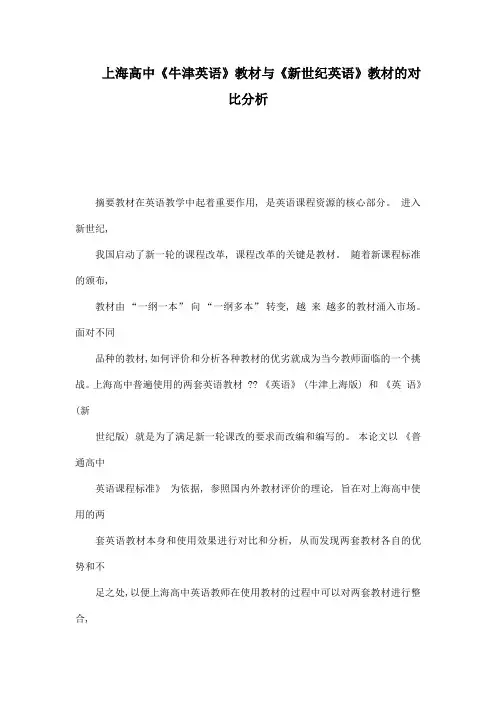
上海高中《牛津英语》教材与《新世纪英语》教材的对比分析摘要教材在英语教学中起着重要作用, 是英语课程资源的核心部分。
进入新世纪,我国启动了新一轮的课程改革, 课程改革的关键是教材。
随着新课程标准的颁布,教材由“一纲一本”向“一纲多本”转变, 越来越多的教材涌入市场。
面对不同品种的教材,如何评价和分析各种教材的优劣就成为当今教师面临的一个挑战。
上海高中普遍使用的两套英语教材 ?? 《英语》 (牛津上海版) 和《英语》(新世纪版) 就是为了满足新一轮课改的要求而改编和编写的。
本论文以《普通高中英语课程标准》为依据, 参照国内外教材评价的理论, 旨在对上海高中使用的两套英语教材本身和使用效果进行对比和分析, 从而发现两套教材各自的优势和不足之处,以便上海高中英语教师在使用教材的过程中可以对两套教材进行整合,扬长避短,让教材更好地为教学服务,最终达到提高英语教学质量的目的。
本论文共分为五个部分。
第一章“引论”部分主要介绍了研究背景、研究目的与意义、研究内容与方法以及本论文的框架结构。
第二章“理论框架与文献综述”部分阐述了教材的定义和作用、教学大纲、国内外外语教材评价的理论和国内外教材对比的研究现状。
第三章“两套教材的对比研究”主要是对两套教材进行宏观和微观对比分析。
宏观对比分析了教材编写的宏观设计指导原则、教材编写的主框架结构和单元课程设置模式。
微观对比分析主要从语言知识、语言技能、学习策略和文化意识四方面来对比,重点对比分析了两套教材的词汇、语法、听、说、读、写等方面。
第四章“两套教材的效果对比分析”主要从教师调查、学生调查和两套教材使用效率对比分析来看两套教材的使用效果。
第五章“研究结果与思考”通过前面几章对两套教材的对比分析、调查和实验总结出两套教材的优势和不足之处, 并提出一些建议, 供教材编写者和使用两套教材的教师参考。
关键词 : 牛津教材,新世纪教材,对比分析viABSTRACTAs a core of curriculum resources, English teaching materials play an importantrole in English language teaching. A new century witnessed a new round ofcurriculum reform and the key to the curriculum reform is the textbook. With thepromulgation and implementation of the new curriculum standards, the policy haschanged from “one textbook for one syllabus” to “diverse textbooks f or one syllabus ”,causing more and more textbooks available on the market. Facing varieties oftextbooks, how to evaluate and analyze the diverse textbools is becoming achallenging task to the teachers nowadays To meet the requirements of the new round of the curriculum reform, two sets ofsenior high school English textbooks------Oxford English Shanghai Edition andNew Century English are adapted and compiled, which are commonly used in almostall the Shanghai middle schools now. Based on National English CurriculumStandards of Compulsory Education for Full-time Senior Middle Schools Trail andreferring to the theories of textbook evaluation at home and abroad, this thesis isintended to compare and analyze the two sets of English textbooks used in Shanghaisenior high schools, hoping to discover some advantages and disadvantages of the twosets of textbooks. In this way, the teachers can integrate the two sets of textbooks,taking full advantage of the strong points and avoiding the weak points, to improvethe English teaching quality This paper consists of five chapters The first chapter serves as an introduction, covering the background, significance,methods and the framework of the study The second chapter is about some theories and literature review, which presentsthe definition and funtion of teaching materials, teaching syllabuses, the theories onforeign language textbook evaluation at home and abroad, and the situation ofcomparative study in English textbooksThe third chapter is concerned with the comparative analysis of the two sets oftextbooks from the macro and micro perspectives. A macro-comparative analysisviiinvolves the guiding ideology of textbook compilation, the main framework oftextbook complilation and the designing pattern of every unit. A micro-comparativeanalysis is made from the perspective of language knowledge, language skills,learning strategies and cultural awearness, focusing on vacabulary, grammar, listening,speaking, reading and writing The fourth chapter discusses the effect of using the two sets of textbooksaccording to the results of the investigation carried out with the teachers and studentsinvolved The last chapter summarizes the advantages and disadvantages of the two sets ofthe textbooks on the basis of the comparative analysis and the results of theinvestigation and the experiment in the preceding chapters, and puts forward somesuggestions for the compilers and the teachers to consultKey words: Oxford English, New Century English, comparative analysisviiiTABLE OF CONTENTS ACKNOWLEGEMENTS I摘要.VIABSTRACT.VII图表索引.VII第一章引论 11.1 研究背景 11.1.1 高中英语课程标准. 11.1.2 我国的中小学教材建设与发展. 2 1.1.3 上海高中英语教材使用情况 3 1.2 研究目的与意义 31.2.1 研究目的31.2.2 研究意义41.3 研究内容与方法 41.3.1 研究内容41.3.2 研究方法51.4 论文结构6第二章理论框架与文献综述72.1 教材的定义. 72.2 教材的作用. 82.3 外语教材与教学大纲 92.3.1 教学大纲的定义. 92.3.2 教学大纲的种类. 92.4 外语教材开发与编写原则142.5 教材评价的定义 162.6 外语教材的评价理论. 162.6.1 国外的教材评价研究 162.6.2 国内的教材评价研究 192.7 国内外教材对比研究状况. 21第三章两套教材的对比研究 223.1 两套教材简介. 223.1.1 上海高中牛津英语简介223.1.2 高中新世纪英语简介 233.2 宏观对比分析. 233.2.1 教材编写的宏观设计指导原则24 3.2.2 教材编写的主框架结构253.2.3 单元课程设置模式. 253.3 微观对比分析263.3.1 语言知识对比 27ix3.3.2 语言技能对比分析: 443.3.3 学习策略对比分析. 703.3.4 文化意识对比分析. 73第四章两套教材的效果对比分析. 76 4.1 教师调查 764.1.1 教师问卷 764.1.2 教师访谈 804.2 学生调查 834.3 两套教材使用效率对比分析. 86第五章研究结果与思考885.1 两套教材的优势与不足 885.1.1 两套教材的优势 885.1.2 两套教材的不足之处. 915.2 对教材修订者和教师的建议935.2.1 对教材修订者的建议 935.2.2 对教师的建议. 935.3 本论文的不足之处95BIBLIOGRAPHY96附录. 101附录 I 牛津教材任务前词汇输入截图101附录 II 牛津教材任务后词汇输入截图. 102附录 III 新世纪英语教材任务后词汇输入截图. 103 附录 IV 牛津教材口语截图104附录 V 新世纪教材口语截图106附录 VI 牛津教材写作截图107附录 VII 新世纪教材写作截图 108附录 VIII 《课程标准》中的目标结构图 110附录 IX 上海《牛津高中英语》教材评价的问卷调查教师卷. 111 附录 X 上海《新世纪高中英语》教材评价的问卷调查教师卷. 113 附录 XI 上海《牛津英语高中英语》教材评价的问卷调查学生卷115 附录 XII 上海《新世纪高中英语》教材评价的问卷调查学生卷117 x图表索引表 1 牛津教材核心词汇统计. 30表 2 新世纪教材核心词汇统计 30表 3 两套教材核心词汇对比图. 31表 4 牛津教材拓展词汇统计31表 5 新世纪教材拓展词汇统计. 32表 6 两套教材拓展词汇对比图 32表 7 牛津教材附带词汇统计. 33表 8 新世纪教材附带词汇统计 33表 9 两套教材附带词汇对比图. 34表 10 牛津教材词组统计34表 11 新世纪教材词组统计. 35表 12 两套教材词组统计对比图. 35表 13 新世纪教材专有名词统计36表 14 两套教材总词汇量对比 36表 15 牛津教材高一下册 U1 Reading 核心词汇复现率统计. 37表 16 新世纪教材高一上册 U2 Reading 核心词汇复现率统计 38表 17 两套教材语法项目对比 39表 18 两套教材语法练习类型统计. 43表 19 两套教材高一上学期听力材料字数统计. 46表 20 两套教材高一上学期听力材料难度统计46表 21 两套教材听力材料类型统计 48表 22 两套教材听力材料类型对比图 48表 23 两套教材高二下学期听力内容对比. 48表 24 牛津教材高一年级听力题型分布50表 25 新世纪教材高一年级听力题型分布. 50表 26 牛津教材高三上学期口语内容与单元主题对比. 51 表 27 新世纪教材高三上学期口语内容与单元主题对比52 表 28 两套教材题材对比55表 29 两套教材高一主课文难度对比 57表 30 两套教材高二主课文难度对比 57表 31 两套教材高三主课文难度对比57表 32 两套教材主课文平均难度对比 57表 33 高考阅读语篇难/ 易读性抽样统计. 57表 34 两套教材主课文难度对比图. 58表 35 两套教材高一拓展阅读难度对比58表 36 两套教材高二拓展阅读难度对比58表 37 两套教材高三拓展阅读难度对比 58表 38 两套教材拓展阅读平均难度对比59表 39 两套教材拓展阅读难度对比图 59表 40 两套教材平均难度对比 59表 41 牛津教材高一读前活动分布. 62xi表 42 新世纪教材高一读前活动分布 62表 43 牛津教材高一读前活动类型图 62表 44 新世纪教材高一读前活动类型图62表 45 牛津教材高一阅读活动分布. 63表 46 新世纪教材高一阅读活动分布 63表 47 牛津教材高一阅读活动类型图. 64表 48 新世纪教材高一阅读活动类型图64表 50 新世纪教材高一读后活动分布 65表 51 牛津教材高一读后活动类型图 66表 52 新世纪牛津教材高一读后活动类型图 66表 53 两套教材写作项目对比 67表 54 两套教材学习策略对比 71表 55 教师问卷题目分布77表 56 教师对教材的宏观评价数据统计77表 57 教师对词汇、语法的评价数据统计78表 58 教师对听、说、读、写的评价数据统计79表 59 教师对学习策略、文化意识和其它的评价数据统计 79 表 60 学生问卷题目分布83表 61 学生的英语学习情况和对教材的宏观评价数据统计 84表 62 学生对词汇、语法态度的数据统计. 84表 63 学生对听、说态度的数据统计 85表 64 学生对读、写态度的数据统计 85表 65 学生对学习策略、文化意识和练习态度的数据统计 85表 66 两所学校 2011 年普陀区二模考试成绩对比 87表 67 两所学校 2011 年高考成绩对比 87表 68 两所学校三次成绩对比图88xii第一章引论1.1 研究背景1.1.1 高中英语课程标准英语在当今世界上的地位特殊, 不仅使用的人数多达十几个亿 ,而且覆盖面很广, 在政治、经济、外交、贸易、科技、文化、通讯、科研、娱乐、网络等许多领域被广泛应用。
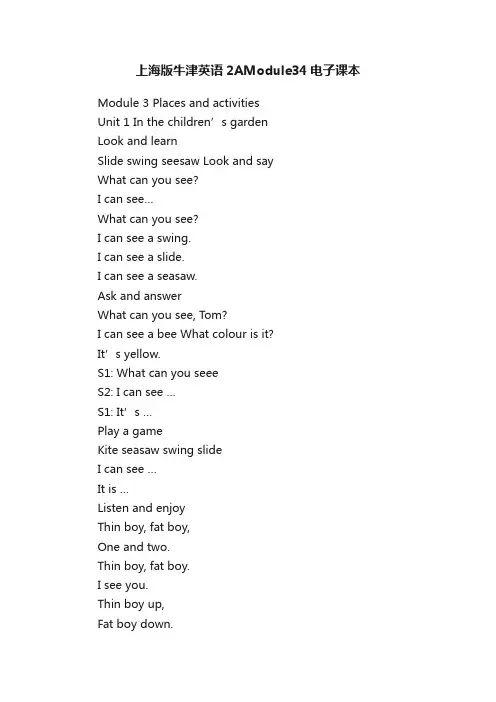
上海版牛津英语2AModule34电子课本Module 3 Places and activitiesUnit 1 In the children’s gardenLook and learnSlide swing seesaw Look and sayWhat can you see?I can see…What can you see?I can see a swing.I can see a slide.I can see a seasaw.Ask and answerWhat can you see, Tom?I can see a bee What colour is it?It’s yellow.S1: What can you seeeS2: I can see …S1: It’s …Play a gameKite seasaw swing slideI can see …It is …Listen and enjoyThin boy, fat boy,One and two.Thin boy, fat boy.I see you.Thin boy up,Fat boy down.You like to play,Up and down.Big dog, small dogs,One, two, three.Big dog, small dogs,I can see.Big dog up,Small dogs down.They like to play,Up and down.Learn the lettersMm mouse Nn netI can see a mouse.I can see a man.The man has a net.The mouse is in the net.Unit 2 In my roomLook and learnBag box desk chair Look and say Put … in / on …①Put the book in the bag, Eddie. OK, Dad.②Put the bag in the box, please. Yes, Dad.③Put the box on the chair, please. OK, Dad.④Oh, no. Put the box on the desk. All right.Say and actKitty’s desk①Look at your desk, Kitty.②Put the books in the bag, please.Ok, Mum.③Put the pencils in the pencil case, please. All right. Play a gameA. carB. bookC. bear①Oh, Ben. Look at your room.②I’m sorry, Mum.③Put the books in the bag, please.Put the car on the desk, please.Put the bear in the box, please.④OK, Mum.Listen and enjoyI love my roomLike Kitty and Ben.I use the boxEvery day!I love my roomLike Kitty and Ben.I keep it cleanEvery day!Learn the lettersOo orange Pp pig P aula has an o range.It’s o n a p late.It’s for her p ig.Her p ig is fat and bigWith four short legs.O ink! O ink! O ink!Come and eat the o range.It’s o n the p late.Unit 3 In the kitchenLook and learnbowl plate spoon chopsticks Say and act Cook dinner①A spoon?No, thanks.②Chopsticks?Yes, please.③Give me a plate, please.Here you are.④Dinner is ready!I’m coming.Look and sayHow many…?There is / are…?This is my kitchen.How many bowls?There are four bowls.How many spoons?There is one.Enjoy a storyNaughty Ginger①There is a table and a chair in the room.②There are two bowls on the table.③Ginger is on the chair.④L ook! Ginger can jump.⑤The bowls are on the floor.⑥Ginger is under the chair.Learn the lettersQq queen Rr rabbit The queen is fat.She’s sitting on the chair.The rabbit is fat.He’s sitting under the chair.Module 4Unit 1 In the skyLook and learnSun moon starLook and sayLook at…Can you see …?Look at the sky. Can you see the moon?Yes, I can.Is it big?Yes. I t’s big. It’s bright.Say and actIn the evening①Look at the sky. Can you see the stars?②How many stars? One, two, three …③Can you see the moon? No, I can’t. Play a game ①Can you see the sun? Yes, I can.S1: Can you see …?S2; Yes, I can. / No, I can’t.Listen and enjoyThe starTwinkle, twinkle, little star,How I wonder what you are!Up above the world so high,Like a diamond in the sky.Twinkle, twinkle, little star,How I wonder what you are! Learn the letters Ss soup Tt tableTom’s rabbit is smooth and soft.Tom’s rabbit sits on the tableAnd eats Tom’s soup.Unit 2 In the forestLook and learnFox hippo meat grass Say and actWild animals①Look at me.I’m a fox.I’m small.I like meat.②Look at me.I’m a hippo.I’m big.I like grass.Look and sayLook at …It likes …①Look at the animals.②Look at the lion. It’s big. It likes meat.Look at the monkey. I t’s small. It likes bananas.③Look at the hippo. It likes grass.Look at the hippo’s mouth.Wow! It’s so big!Listen and enjoyI’m a fox, fox, fox.And I’m nice, nice, nice.I’m orange, orange, orange.And I can run, run, run.I’m a rabbit, rabbit, rabbit.And I’m cute, cute, cute.I’m white, white, white.And I can hop, hop, hop.I’m a monkey, monkey, monkey.And I’m naughty, naughty, naughty.I’m brown, brown, brown.And I can swing, swing, swing.Learn the lettersUu umbrella Vv van Ww window Wendy is in a van, With two umbrellas in her hands.One is black. One is red.She takes them to her friends.Oh, raindrops fall on her head.Wendy closes the windowWith her hand.Unit 3 In the streetLook and learnFlower treeLook and sayDon’t …①Don’t pick the flowers.I’m sorry.②Don’t cl imb the tree.I’m sorry.Play a gameDraw colour cutEnjoy a storyIn the park①I like this park. It’s big. It’s nice.②Look at this flower. I t’s beautiful. Don’t pick the flowers, Danny.③Oh! What’s this?It’s a bee.④Help! Help!Don’t run, Danny.⑤Don’t cry, Danny.Learn the lettersXx box Yy yellow Zz zebra Look at my z oo. You can come, too.Can you seeA z ebra in a bo x?Yes, I can seeA z ebra in a y ellow bo x.。
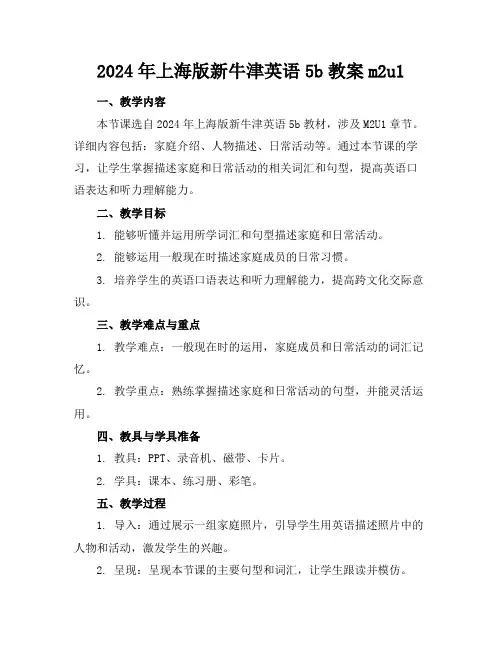
2024年上海版新牛津英语5b教案m2u1一、教学内容本节课选自2024年上海版新牛津英语5b教材,涉及M2U1章节。
详细内容包括:家庭介绍、人物描述、日常活动等。
通过本节课的学习,让学生掌握描述家庭和日常活动的相关词汇和句型,提高英语口语表达和听力理解能力。
二、教学目标1. 能够听懂并运用所学词汇和句型描述家庭和日常活动。
2. 能够运用一般现在时描述家庭成员的日常习惯。
3. 培养学生的英语口语表达和听力理解能力,提高跨文化交际意识。
三、教学难点与重点1. 教学难点:一般现在时的运用,家庭成员和日常活动的词汇记忆。
2. 教学重点:熟练掌握描述家庭和日常活动的句型,并能灵活运用。
四、教具与学具准备1. 教具:PPT、录音机、磁带、卡片。
2. 学具:课本、练习册、彩笔。
五、教学过程1. 导入:通过展示一组家庭照片,引导学生用英语描述照片中的人物和活动,激发学生的兴趣。
2. 呈现:呈现本节课的主要句型和词汇,让学生跟读并模仿。
3. 练习:进行小组活动,让学生互相用所学句型描述家庭成员和日常活动。
4. 应用:播放听力材料,让学生完成相关练习,巩固所学知识。
5. 巩固:进行角色扮演,让学生模拟真实场景,运用所学知识进行交流。
六、板书设计1. M2U1 Family and Daily Activities2. 主要句型:This is my family.He/She isHe/She likesThey areThey like3. 主要词汇:father, mother, brother, sister, grandpa, grandma, like, read, watch TV, play football, swim, cook, clean七、作业设计1. 作业题目:(1)用一般现在时描述你的家庭成员,至少写出五句话。
(2)根据所给图片,描述家庭成员的日常活动,至少写出五句话。
2. 答案:(1)Example: My father is a teacher. He likes reading books. My mother is a doctor. She likes cooking. My brotheris a student. He likes playing football. My sister is in kindergarten. She likes drawing. My grandpa is retired. He likes watching TV. My grandma is a housewife. She likes cleaning.(2)Example: In the picture, my father is reading a newspaper. My mother is cooking dinner. My brother is playing football with his friends. My sister is drawing a picture. My grandpa is watching TV. My grandma is cleaning the living room.八、课后反思及拓展延伸1. 反思:本节课通过实际场景引入,激发学生的兴趣。
上海版牛津小学英语课本全部单词带音标(分类版)26个英文字母Aa Bb Cc Dd Ee Ff Gg Hh Ii Jj Kk Ll Mn Nn Oo Pp Qq Rr Ss Tt Uu Vv Ww Xx Yy Zz学校Schoolshool学校[sku:l]n.uniform 制服;军服['ju:ni fɔ:m] n.term 学期;期限[tə:m] n class 班级[klɑ:s]n.book书[buk] n.pencil 铅笔['pensəl] n.bag 书包[bæɡ] n. pen 钢笔[pen] n.ruler 尺子['ru:lə] n.pencil-case 铅笔盒['penslkeis] n.eraser 橡皮[i'reizə] n.crayon 蜡笔['kreiən] n.sharpener 卷笔刀['ʃɑ:pənə] n.ink墨水[iŋk] nlesson功课;课程['lesən]n.paper纸['peipə]n.text 课文;文本[tekst] n brush毛笔[brʌʃ]n.have a lesson上课Chinese book 语文书have lessons上课young pioneer 少年先锋队员eye-exercises 眼保操student(大中学)学生['stju:dənt] n classmate同学['klɑ:smeit] n homework家庭作业['həumwə:k] n pupil小学生['pjupəl]n.blackboard黑板['blækbɔ:d] n red scarf 红领巾playground操场['pleiɡraund] n exercise-book 练习本have English class上英语课begin classes 开始上课talk in English 用英语讲paint 颜料[peint] n morning exercises早操timetable 课程表['taim,teibl] n teacher教师['ti:tʃə]n.break 课间休息;休息[breik] n felt pen 毡头笔[felt] nnote 纸币;笔记[nəut] ngo home 回家teacher’s desk 讲台seat座位[si:t] n class is over下课了school is over. 放学了课程Subjectsubject 科目[' sʌbdʒikt]n. Chinese 语文['tʃ ai'ni:z]n. English英语['iŋgliʃ]n.math 数学[mæθ] n上海版小学牛津英语单词汇总science科学;技术['saiəns] n physical education 体育课['fizikəl] [,edjukeiʃn] nart美术[ɑ:t]n.music音乐['mju:zik] ntext 课文;文本[tekst] n书Bookpoem诗['pəuim] n module 单元;组件['mɔdju:l] n unit 单元;单位['ju:nit] n word 单词;言辞;歌词[wə:d] npage 页[peidʒ] n letter 字母;文字['letə] n sheet 印刷品;表格[ʃi:t] n vocabulary 词汇[və'kæbjuləri] ngrammar语法['græmə] n dictionary 字典['dikʃəneri]book书[buk] n.content 目录;内容[kən'tent] n身体Bodybody 身体['bɔdi] n. hair头发[hεə]n.head 头[hed] n.face 脸[feis] n.hand 手[hænd]n.mouth 嘴[mauθ] n.nose 鼻子[nəuz] n. ear 耳朵[iə] n.eye 眼睛[ai] n. finger 手指['fiŋɡə] n.arm 胳膊[ɑ:m] n.feet脚(复数)['fi:t] n.foot 脚[fut] n.stomach ['stʌmək]n.throat喉咙[θrəut]n.teeth牙(复数) [ti:θ] ntooth 牙齿[tu:θ] n.toe 脚趾[təu] n.leg 腿[leɡ] n. knee 膝盖[ni:] n.back后背[bæk] n bone 骨头[bəun] n颜色colourcolour 颜色['kʌlə] n.red 红色的[red] adj.yellow 黄色的['jeləu] adj. green 绿色的[ɡri:n] adj.blue 蓝色的[blu:] adj.purple 紫色的['pə:pl] adj.white 白色的[hwait] adj. black 黑色的[blæk] adj.orange 橙色的['ɔrin dʒ] adj.pink 粉色的[piŋk] adj.brown 棕色的[braun] adj.grey 灰色的[ɡrei] adj.2上海版小学牛津英语单词汇总3动物Animalanimal 动物['ænim əl] n dog 狗 [d ɔɡ]n.cat 猫;猫科动物[kæt] n. kitty 小猫 ['kiti:]n. puppy 小狗['p ʌpi] n rabbit 兔子['ræbit] n. duck 鸭子 [d ʌk]n.hare 野兔[h εə] n duckling 小鸭['d ʌkliŋ] n pig 猪[pi ɡ] n. parrot 鹦鹉['pær ət] n bear 熊[bεə] n.bird 鸟;禽[b ə:d] n.bee 蜜蜂,勤劳的人 [bi:]n. elephant 大象['elif ənt] n. mouse 老鼠[maus] n.squirrel 松鼠['skw ə:r əl] n. monkey 猴子;顽童['m ʌŋki] n. swan 天鹅[sw ɔn] ngiraffe 长颈鹿 [d ʒi'r ɑ:f] n. zebra 斑马;有斑纹的['zi:br ə] n lizard 蜥蜴['liz əd] n fox 狐狸;狡猾的人[f ɔks] n panda 熊猫['pænd ə] n. crocodile 鳄鱼 ['kr ɔk ə,dail] n. chick 小鸡 [t ʃik]n. cow 母牛[kau] nchicken 鸡 ['t ʃikin] n.dinosaur 恐龙['dain əs ɔ:] n donkey 驴;傻瓜['d ɔŋki] n dragon 龙 ['dræɡən]n. snake 蛇[sneik] nlion 狮子;勇敢的人['lai ən] n tiger 老虎;凶残的人['tai ɡə] n owl 猫头鹰[aul] nfish 鱼 [fi ʃ] n.sheep 羊;害羞的人[ʃi:p] n tortoise 乌龟['t ɔ:t əs] npet 宠物;宝贝[pet] nkangaroo 袋鼠[,kæŋgə'ru:] n caterpillar 毛虫;蝶['kæt ə,pil ə] n butterfly 蝴蝶 ['b ʌt əflai]n. dolphin 海豚['d ɔlfin] n moth 蛾;蛀虫[m ɔθ] n goose 鹅[ɡu:s] n frog 青蛙[fr ɔɡ] n tadpole 蝌蚪['tædp əul] n geese 鹅(复数) [ɡi:s] wolf 狼[wulf] n seal 海豹[si:l] n horse 马[h ɔ:s] nshark 鲨鱼['ʃɑ:k] n cocoon 茧;卵袋[k ə'ku:n] n食物Foodfeeler 触角;触须['fi:l ə] n insect 昆虫['insekt] nfood 食物 [fu:d] n. vegetable 蔬菜['ved ʒit əbl]n. fruit 水果[fru:t]n. drink 饮料[driŋk] n bread 面包[bred] ncake 蛋糕[keik] n上海版小学牛津英语单词汇总4BigMac 巨无霸n. hot dog 热狗McChicken 麦香鸡 nsausage 香肠['s ɔ:sid ʒ] n hamburger 汉堡包['hæmb ə: ɡə] n chicken 鸡肉['t ʃikin] n French fries 榨薯条[frent ʃfraiz] n. chocolate 巧克力['t ʃɔk əlit] n crisp 松脆饼干;薯片[krisp]n. Coke 可乐[k əuk] nwater 水['w ɔ:t ə] n tea 茶[ti:] nmilk 牛奶[milk] njuice 果汁;汁[d ʒu:s] n coffee 咖啡['k ɔfi] n egg 蛋[e ɡ] nrice 米饭[rais] njam 果酱 [d ʒæm]n.noodles 面条(通常复数['nu:dl] n carrot 胡萝卜;红头发['kær ət] n tomato 番茄[t ə'm ɑ:təu]n. potato 马铃薯[p ə'teit əu] n cabbage 卷心菜 ['kæbid ʒ] n honey 蜂蜜['h ʌni] n apple 苹果['æpl] nbean 豆[bi:n] n.pear 梨[pεə] npineapple 菠萝;凤梨['pain,æpl] n orange 橘子['ɔrind ʒ] nbanana 香蕉[b ə'n ɑ:nə] n. watermelon 西瓜['w ɔ:t ə,mel ən] n grape 葡萄;葡萄酒[greip] n lime 酸橙;菩提树[laim] n plum 梅子;洋李[pl ʌm] a butter 黄油;奶油['b ʌt ə] n durian 榴莲['dju əri ən] nsugar 糖['ʃug ə] n flour 面粉;粉状物质[flau ə] n corm 谷物[k ɔ:m] nsalt 盐 [s ɔ:lt] n 数字Numbernumber ['n ʌmb ə] n. one 一[w ʌn] num. two 二[tu:] num. three 三[θri:] num. four 四[f ɔ:] num. five 五[faiv] num.six 六[siks] num. seven 七['sev ən] num. eight 八[eit] num. nine 九[nain] num.ten 十[ten] num.eleven 十一[i'lev ən] num. twelve 十二 [twelv] num. thirteen 十三['θə:'ti:n] num. fourteen 十四['f ɔ:'ti:n] num. fifteen 十五['fifti:n] num. sixteen 十六['siks'ti:n] num. seventeen 十七[,sev ən'ti:n] num. eighteen 十八['ei'ti:n] num. nineteen 十九[,nain'ti:n] num. twenty 二十['twenti] num. thirty 三十['θə:ti] num. forty 四十['f ɔ:ti] num.fifty 五十['fifti] num.上海版小学牛津英语单词汇总5am (我)是[æm] v.is (他,她,它)是[iz ] v.主格NominativeI 我[ai] pron.he 他 [hi: ] pron. we 我们 [wi:] pron.宾格Objective Caseme 我 [mi:] pron him 他 [him] pron us 我们 [ʌs] pron形容词性 物主代词my 我的[mai] pron his 他的[hiz] pronare (你,你们,我们,他们,她们,它们) 是[ɑ:] v.you 你,你们[ju:] pron. she 她 [ʃi:] pron.they 他(她;它)们 [ðei] pron. it 它 [it] pron.you 你,你们 [ju:] pron. her 她 [h ə:] pronthem 他(她;它)们[ðem] pron it 它 [it] pron.your 你的;你们的[j ɔ: ] pron her 她(宾格) [h ə:] pronsixty 六十['siksti] num.seventy 七十['sev ənti] num. eighty 八十['eiti] num.ninety 九十['nainti] num.hundred 一百['h ʌndr əd] num. thousand 一千['θauzənd] num.twenty-five 二十五 num first 第一;首先[f ə:st] numsecond 第二['sek ənd] num third 第三[θə:d] num fourth 第四 [f ɔ:θ] num fifth 第五[fif θ] num sixth 第六[siks θ] num seventh 第七['sevn θ] num eighth 第八[eit θ] num ninth 第九 [nain θ] num tenth 第十[ten θ] num eleventh 第十一[i'levn θ] num twelfth 第十二[twelf θ] numtwentieth 第二十['twentii θ] num thirtieth 第三十['θə:tiiθ] numtwenty-first 第二十一[,twenti'f ə:st] num 冠词Articlea 一 [ei]art. an 一 [ən]art the 这,那[[ði]]art.Be 动词上海版小学牛津英语单词汇总6our 我们的['au ə] pron名词性 物主代词mine 我的 [main] pron his 他的 [hiz] pron ours 我们的['au əz] pron反身代词myself 我自己 [mai'self] pron. itself 它自己[it'self]pron. herself 她自己[h ə:'self] pron. himself 他自己 [him'self] pron. 介词prepositionrom 从……[fr ɔm] prep. about 关于[ə'baut] prep. above 在……上方[ə'b ʌv] prep. behind 在……后面[bi'haind] prep. down 向下[daun] prep.或ad. after 在…后面['ɑ:ft ə] prep. before 在……之前[bi'f ɔ:] prep. like 像[laik] prep. beside 在……旁边[bi'said] prep. between 在(两者)之间[bi'twi:n] prep up 向上;上升;在……上面 [ʌp] prep.或ad. come in. 进来['k ʌm in] out 向外[aut] prep. out 通过……而出[aut] prep 介词短语from beijing 从北京来的 over there 在那边 their 他(她;它)们的 [ðεə] pron its 它的 [its] pronyours 你的;你们的[ju əz] pron hers 她的[h ə:z] prontheirs 他(她;它)们的[ðєəz] pronits 它的 [its] pronyourself 你自己[j ɔ:'self] pron. yourselves 你们自己[j ɔ:'selvz] pron. themselves 他们自己[ðəm'selvz] pron. ourselves 我们自己[,au ə'selvz] pron.self 自己;自我;本质[self] nin 在……之内[in] prep. into 到……里['intu: ] prep. at 在... ;在……时[æt] prep. to 到;向[tu: ] prep. by 在…旁;靠近 prep. on 在……之上(时候)[ɔn ] prep. under 在……下面['ʌnd ə] prep plus 加[pl ʌs ] prep.minus 减 'main əs] prep. inside 在……里面[in'said] prep outside 在……外面['aut'said] prep away 离……;外出[ə'wei] near 靠近[ni ə] prep over 越(过) ['əuv ə] prep. for 为;代替;因为;为得到[ f ɔ:] prep with . 用;和…在一起[wið] prep. through 穿过[θru:] prepat the zoo 在动物园里 at three 在三时;在三点上海版小学牛津英语单词汇总7go to the door 到门那儿去 in front of 在…前面 out of 向(在)…外面 wait for 等候it's time for 是…的时候了 play with 玩… be afraid of 害怕 so much like 很像 at the back 在后面 pick up 拾起next to 与……相邻[nekst]地点Placesshool 学校[sku:l]n. park 公园[p ɑ:k] n home 家[h əum]n. house 房屋[haus]n. room 房间[ru:m] n. classroom 教室['kl ɑ:srum] n bathroom 浴室['bæθrum] n kitchen 厨房['kit ʃin] n bookstore 书店['bukst ɔ:] n sitting room 起居室 study 书房['st ʌdi] n theatre 剧场['θiət ə] n restaurant 餐厅['rest ər ɔnt] n road 路;街道[r əud] n beach 海滩[bi:t ʃ] n farm 农场[f ɑ:m] n jungle 丛林['d ʒʌŋgl] n block 大楼;大厦[bl ɔk] n palace 宫殿['pælis] n 国家Nationnation 国家['nei ʃən]n. at home 在家 look at 看…… a lot of 许多…a pair of trousers 一条裤子 of course 当然[k ɔ:s] look for 寻找 hurry up! 快点! run away 跑掉by underground 乘地铁 try on 试穿put into 放到…里 listen to 听…… library 图书馆['laibr əri] n zoo 动物园[zu:] n cinema 电影院['sin əm ə] n factory 工厂['fækt əri] n square 广场[skwεə] n crossing 十字路口['kr ɔ:siŋ] n bedroom 卧室['bedrum] n living room 客厅 dining room 餐室;餐厅 n hall 食堂,会堂 [h ɔ:l]n. supermarket 超市['sju:p ə,m ɑ:kit] police station 警署;派出所 station 车站;电台;基地['stei ʃən] n tower 塔;高楼['tau ə] n temple 庙宇;圣堂;寺院['templ] n country park 乡村公园['k ʌntri] garden 花园;菜园;游乐场['g ɑ:dn] n castle 城堡['k ɑ:sl] n cage 笼子;监牢[keid ʒ] nnational 国家的['næʃən əl] adj.上海版小学牛津英语单词汇总8China 中国['t ʃai n ə] n America 美国;美洲[ə'merik ə] n England 英国['ingl ənd] n Russia 俄罗斯['r ʌʃə]n. motherland 祖国['m ʌðəlænd] n星期 Weekweek 周,星期[wi:k]n. Tuesday 星期二 ['tju:zdi ] n Thursday 星期四['θə:zdi] n Saturday 星期六 ['sæt ədi] n 月份 Monthmonth 月[m ʌnθ] n. February 二月['febru əri] n April 四月['eipr əl] n June 六月[d ʒu:n] n August 八月[ɔ:'g ʌst] n October 十月[ɔk't əub ə] n 季节 Seasonseason 季节['si:zn] n summer 夏天['s ʌm ə]n. fall 秋天[f ɔ:l] n 衣服 Clothesclothes 衣服[kl ɔθ] n cap 帽子[kæp] n shirt (男式)衬衫[ʃə:t] n scarf 围巾,领巾[sk ɑ:f] n T-shirt T 恤衫 pants 长裤[pænt] n size 大小;尺寸;号码[saiz] n trousers 裤子;长裤['tr au z əz] n Chinese 中国的;汉语;中国人['t ʃai'ni:z] Amercian 美国的;美国人[ə'merik ən] English 英国的;英语;英国人['iŋgli ʃ] Russian 俄语,俄国人['r ʃən] capital 首都['kæpit əl] n the capital of China 中国首都national flag 国旗[flæɡ] Monday 星期一['m ʌndi] n Wednesday 星期三['wenzdei ] n Friday 星期五 ['fraidi] n Sunday 星期天 ['s ʌndi] nJanuary 一月['d ʒænjueri] n March 三月[m ɑ:tʃ] n May 五月[mei]n. July 七月[d ʒu:'lai] n September 九月[sep'temb ə] n November 十一月[n əu'vemb ə] n December 十二月[di'semb ə] nspring 春天[spriŋ] n autumn 秋天['ɔ:t əm]n. winter 冬天 ['wint ə]n.wear 穿戴[wεə] n.或v. coat 上衣[k əut] n blouse (女式)衬衫[blauz] n skirt 裙子;边缘;外围[sk ə:t] n jacket 外衣;夹克;皮['d ʒækit] n dress 连衣裙[dres] n jeans 牛仔裤;斜纹棉布[d ʒi :n] n sock(s) 袜子(复数)[s ɔk ] n上海版小学牛津英语单词汇总9glove 手套[g l ʌv] n职业Jobjob 职业[d ʒɔb]n.peasant 农民['pez ənt] ndoctor 医生;博士['d ɔkt ə] n scientist 科学家['sai əntist] n nurse 护士[n ə:s] n writer 作家['rait ə] nengineer 工程师[,end ʒi'ni ə] n policeman 男警察[p ə'li:sm ən] n cleaner 清洁工['kli:n ə] naccountant 会计[ə'kaunt ənt] n driver 司机['draiv ə] n dentist 牙医['dentist] n cook 厨师[kuk] npostman 邮递员['p əustm ən] n waiter 服务员(男)['weit ə] n diver 跳水者;潜水员['daiv ə] n soldier 士兵;兵蚁['s əuld ʒə] n家庭Familyfamily 家庭;家族['fæmili] n family tree 家谱[tri:] mother 母亲['m ʌðə]n.dad 爸爸(口语)[dæd] n father 父亲['f ɑ:ðə]n. son 儿子;女婿[s ʌn] n aunt 姑姑;婶;姨[ɑ:nt] n sister 姐妹['sist ə] ncousin 堂兄弟姐妹['k ʌz ən]n. niece 侄女;外甥女[ni:s]n.人Peoplepeople 人(复数)['pi:pl]n.mask 面具;遮蔽物;口罩[m ɑ:sk] n shoe(s) 鞋子(复数)[ʃu:] nwork 工作[w ə:k] n.或v. farmer 农民['f ɑ:mə] nartist 画家;艺术家['ɑ:tist] n teacher 教师['ti:t ʃə] n student 学生['stju:d ənt]n.model 模型;模特;模范['m ɔdl] n actress 女演员['æktris] n actor 男演员['ækt ə] npolicewoman 女警[p ə'li:s,wum ən] n salesperson 销售员['seilz,p ə:s ən] n TV reporter 电视台记者[ri'p ɔ:t ə] fireman 消防员['fai əm ən] nsinger 歌唱家;歌手['sind ʒə] n pilot 飞行员;舵手['pail ət] n waitress 女服务员['weitris] n zoo keeper 饲养员['ki:p ə] nshop assistant 营业员[ə'sist ənt] n ambulance (man) 急救员['æmbjul əns] nlove 爱[l ʌv] nfamily member 家庭成员['memb ə] n parents 父母['pєər ənts] nmum 妈妈(口语)[m ʌm] ngrandpa 爷爷;外公['grændp ɑ:] n grandma 奶奶;外婆['grændm ɑ:] n daughter 女儿;媳妇;妇女['d ɔ:t ə] n uncle 叔叔舅舅姨夫姑父['ʌŋkl] n brother 兄弟['br ʌðə] n.nephew 侄子;外甥['nefju:]n.man 男子[mæn] n上海版小学牛津英语单词汇总10friend 朋友[frend] n child 小孩[t ʃaild] n children 小孩(复数['t ʃildr ən]n. baby 婴儿;幼畜['beibi] n Miss 女士;小姐;少女[mis] n Mr.先生(mister 缩写) ['mist ə] n Mrs.太太,夫人['misiz]n.运动Sportsports 体育运动[sp ɔ:ts] n basketball 篮球['bæskitb ɔ:l] n volleyball 排球['v ɔlib ɔ:l]n. soccer 英式足球['s ɔk ə]n. bat 球拍;击球[bæt] n 天气Weatherweather 天气['weðə] n. sun 太阳[s ʌn] n sky 天空[skai] n star 星星 [st ɑ:] n cloud 云[klaud] n rain 雨;下雨[rein] n raindrop 雨点['reindr ɔp] n snow 雪;下雪[sn əu]n. wind 风[wind]n. storm 暴风雨[st ɔ:m] n thunder 雷;雷声['θʌnd ə] n 餐Mealmeal 一餐[mi:l]n. breakfast 早餐['brekf əst] n supper 晚饭;晚餐会['s ʌp ə] n dessert 甜点;餐后甜点[di'z ə:t] n have breakfast 吃早饭 家具Furnituremen 男子(复数)[men] n woman 妇女['wum ən] n women 妇女['wimin]n. boy 男孩;儿子;小儿子[b ɔi] n girl 女孩;女儿[ɡə:l] nMr. and Mrs. white 怀特先生和夫人 lady 女士;夫人;小姐['leidi] ngentleman 先生,绅士['d ʒentlm ən]n tennis 网球['tenis]n. tabletennis 乒乓球 pingpong 乒乓球;桌球['piŋp ɔŋ] n badminton 羽毛球['bædmint ən]n. football 足球;橄榄球['futb ɔ:l] nearth 地球[ə:θ]n. air 空气;天空;气氛[εə] n moon 月亮;月光[mu:n] n sunny 晴朗的['s ʌni] adj. moon 月亮[mu:n]n. cloudy 多云的['klaudi]n. rainy 雨天;多雨的['reini] adj. rainbow 彩虹['reinb əu] n snowy 下雪的['sn əui] adj. windy 有风的;风大的['windi] adj. stormy 暴风雨的['st ɔ:mi]n.lightning 闪电['laitniŋ]n.lunch 午餐[l ʌnt ʃ] n dinner 晚餐['din ə]n. dish 碟子;盘子[di ʃ] n dining 进餐['dainiŋ] n eat breakfast 吃早饭[i:t] ['brekf əst]furniture家具['fə:nitʃə]n.wall 墙[wɔ:l] nchair 椅子[tʃɛə] ndoor 门;出口[dɔ:] nsofa 沙发;长椅['səufə] nroof 屋顶;车顶[ru:f] n一些名词box 盒子[bɔks] numbrella 伞[ʌm'brelə] nbottle瓶;酒['bɔtl] nnewspaper报纸['nju:s,peipə] n key钥匙[ki:] nspoon 勺子[spu:n] nplate 盘子[pleit] n screwdriver 螺丝刀['skru:,draivə] bell铃,铃声[bel] n.bin 垃圾箱;容器[bin] n hammer 锤子;链球['hæmə] n mirror 镜子;榜样['mirə] n phone 电话[fəun]n.hoop 呼啦圈;戒指[hu:p] n telephone电话['telifəun] n. watch手表;[wɔtʃ] nbasket 筐['bɑ:skit] ntoy car玩具车clock钟[klɔk] nparty 聚会;党派['pɑ:ti] n skateboard 滑板['skeitbɔ:d] n puppet 木偶;傀儡['pʌpit] n parcel 小包;包裹['pɑ:sl] ntape 胶带;带子;磁带[teip] n swing 荡;荡秋千[swiŋ] vdrill 钻头钻床[dril] nbell 铃;门铃[bel] nbench 长凳[bentʃ] nfloor 地板[flɔ:] nwindow窗['windəu] ncupboard 小厨;碗柜['kʌbəd] nshelf 书架[ʃelf] ntable桌子['teibl] nknife小刀;手术刀;匕首[naif] n glass玻璃杯[ɡlɑ:s] ncup 杯子;奖杯[kʌp] nboard 写字板;牌子;伙食[bɔ:d] n chopsticks筷子(复数)['tʃɔpstik] n fork 叉子;岔口[fɔ:k] nbrush刷(子) [brʌʃ] ncushion 靠垫;坐垫['kuʃən] n scissors 剪刀['sizəz] nglue 胶水[glu:] nshaker搅拌器['ʃeikə] nglasses 眼镜;双筒望远镜['glɑ:siz] n packet 小包['pækit] nsunglasses 太阳镜['sʌnglɑ:siz] n sketchbook 写生簿['sketʃbuk] ndoll 玩具娃娃[dɔl] nmap 地图[mæp] nmodel plane模型飞机model ship 模型轮船toy 玩具;玩物[tɔi] nrug 小地毯[rʌg] npuzzle 拼图板;猜谜['pʌzl] nbar 栅栏[bɑ:] nstring 绳子;线[striŋ] ndiary 日记;日记簿['daiəri] n balloon 气球[bə'lu:n] ntype 类型;样式;榜样[taip] nrope 绳子[rəup] nname 名字[neim] nnew新的;新闻[nju:] n money 钱;收入['mʌni] n picture图画;照片['piktʃə] n lake 湖[leik] nway路;路程[wei] nletter信['letə] nMatch比赛;对手[mætʃ] n game游戏[ɡeim] nquestion问题['kwestʃən] n news消息;新闻[nju:z] n nest 鸟巢[nest] nrace比赛[reis] nfun乐趣;娱乐[fʌn]group 组;小组[gru:p] nskate 滑冰(鞋)[skeit] n hiking徒步旅行['haikiŋ] n v shell 贝壳;果壳[ʃel] n computer game 电脑游戏number 号;号码['nʌmbə] n photo 照片['fəutəu] nfront前面;前部;正面[frʌnt] n pioneer 先锋[,paiə'niə] n stream 河;溪[stri:m] naviary 鸟巢禽舍['eiviəri] n stone 石头[stəun] nhole 洞;孔眼[həul] nrock 石头;磐石[rɔk] nisland 岛;安全岛['ailənd] n picnic 野餐['piknik] nwing 翅膀[wiŋ] npond 水池;池塘[pɔnd] n millimeter毫米;公厘['mili,mi:tə] aexpression 表达;表现力;表情[iks'preʃən] nproject 方案;计划[prə'dʒekt] nriver河流;巨量['rivə] nmountain山;山脉['mauntin] nlight 灯;光;火花;眼神['lait] n lamp 灯[læmp]n.robot 机器人['rɔbət] npool 池[pu:l] nswimming-pool 游泳池ground地面[graʊnd] nbasin 盆;脸盆['beisən] nchess 西洋棋[tʃes] nbirthday生日['bə:θdei] nhobby 爱好['hɔbi] ncomic book 漫画['kɔmik] [buk]noise 噪声[nɔiz] nlife 生命;生活[laif] npicture-book 图画书post card 明信片[pəust] [kɑ:d] n matter 事情;麻烦['mætə] ncomic连环图画;喜剧的['kɔmik] n wave 浪;波浪[weiv] nfire 火[faiə] nfountain 喷水池;泉水['fauntin] n rubbish 垃圾;废话['rʌbiʃ] npen friend 笔友thing 东西;事情[θiŋ] ntop 顶部;头顶;山顶[tɔp] nbottom底部['bɔtəm]n.aquarium 水族馆;鱼缸[ə'kwɛəriəm] n way(= method) ['meθəd] 方法ngoal 得分;守门员[gəul] nscore 得分;起跑线;终点线[skɔ:] n elf 小精灵;顽皮的孩子[elf] nshadow 影子;阴影['ʃædəu] n wood木材[wud]n.hay 干草[hei] nlog 原木;木材[lɔg] nroom房间[ru:m] nrule 规则[ru:l] n植物Plantplant植物[plɑ:nt]n.branch 树枝[brɑ:ntʃ] nstalk 主茎[stɔ:k] nseed 种子[si:d] n家用电器computer 计算机[kəm'pju:tə] n TV电视radio 收音机;电台['reidiəu] n乐器Instrument instrument乐器['instrumənt] violin 小提琴[vaiə'lin] ndrum 鼓[drʌm] n交通Traffictraffic 交通['træfik] nstop停车站[stɔp] nsign 指示牌;手势[sain] aeroplane 飞机['ɛərəplein] n motorbike 摩托车['məutəbaik] n tram (有轨)电车[træm] n plane 飞机[plein] ncar 小汽车[kɑ:] nship轮船[ʃip]n.bus stop 公共汽车站[stɔp] ferry摆渡['feri]n.pop 流行;流行音乐[pɔp] n grass 草;草坪[grɑ:s] nlawn草坪[lɔ:n]n.painting 绘画['peintiŋ]nocean 海洋['əuʃən] nsale 打折销售;出售[seil] n invitation 请帖[,invi'teiʃən] nflower花['flauə] ntree 树[tri:] ntrunk 树干;大皮箱[trʌŋk] n sprout 苗;芽[spraut] nsoil 土壤[sɔil] nfan扇子;电扇;螺旋桨[fæn] n fridge 冰箱[fridʒ] nvideo录像机['vidiəu]n.triangle 三角铁['tra iæŋgl] n piano 钢琴[pi'ænəu] nrecorder 八孔直笛[ri'kɔ:də] n guitar 吉他[gi'tɑ:] ntraffic light 红绿灯[lait]traffic rule交通规则ru:l]traffic jam塞车[dʒæm]rolley-bus 无轨电车['trɔlibʌs] n underground. 地铁['ʌndəgraund] n spaceship 宇宙飞船['speisʃip] nbike自行车[baik]n.bicycle 自行车['baisikl]n. boat 小船[bəut] nbus公交车[bʌs]n.wheel 轮子;车轮[hwi:l] nlorry 卡车['lɔ:ri] n一些形容词long长的[lɔŋ] atall高的[tɔ:l] ayoung年轻的[jʌŋ] aold年老的[əuld] agood 好的[ɡud] nbad 坏的[bæd]n.right对的;右边的[rait] a nfat胖的;厚的[fæt] a thick厚的[θik]n.open开;开阔的['əupən] vquiet 安静的['kwaiət] anoisy嘈杂的['nɔizi]a.heavy重的;沉重的['hevi] a early早,早的['ə:li] afar远的[fɑ:] aempty 空的['empti] ahungry饿的['hʌŋɡri]a.tired 疲劳的;累的['taiəd] a happy 高兴的['hæpi] asad 忧伤的;悲伤的[sæd] a bright明亮的;开朗的[brait] a dark黑暗的['dɑ:k]a.soft 柔软的[sɔft] aloud 响的[laud] asweet 甜的;悦耳的[swi:t] a bitter苦的['bitə]a.dry 干的,干旱的[drai] a brave 勇敢的[breiv] nlarge 大的[lɑ:dʒ] abig大的[biɡ]a.giant 巨人的,巨人['dʒaiənt] n blind 瞎的[blaind] n engine 引擎;发动机['endʒin] nshort短的;矮的[ʃɔ:t] ahigh 高的[hai] abig大的[biɡ] asmall小的[smɔ:l] aclean 清洁的[kli:n] adirty脏的['də:ti]n.wrong错误的[rɔŋ]n.left左边的thin瘦的;薄的[θin]n.strong 健壮的;坚固的[strɔŋ] acold 寒冷的[kəuld] ahot 热的[hɔt]a.warm 暖和的[wɔ:m] acool 凉爽的[ku:l] alate 晚的[leit]a.close近的[kləuz]a.full满的,饱的[ful]a.thirsty口渴的['θə:sti]a.excited 兴奋的[ik'saitid] a bored 无聊的;烦人的[bɔ:d] aangry 生气的['æŋgri] ahard 硬的[hɑ:d]a.low轻声的,低的[ləu]a.sour 酸的['sauə]a.salt 咸的[sɔ:lt]a.wet潮湿的[wet]a.dear 亲爱的;可爱的[diə] asmall小的[smɔ:l]a.deaf聋的[def]a.dumb哑的[dʌm]busy 忙['bizi] asharp锋利的[ʃɑ:p]round 圆的[raund] ablunt 钝的[blʌnt] aclever聪明的['klevə]wise 聪明的[waiz]smart聪明的young年轻的[jʌŋ]ugly 丑的['ʌgli] acheap 便宜的[tʃi:p] adear昂贵的;珍贵的[diə] aasleep 睡着的[ə'sli:p] aawake醒着的[ə'weik]rough 粗糙的[rʌf] asmooth光滑的[smu:ð]sore 疼的[sɔ] adaily 每日的;日常的['deili] a sure 当然;一定[ʃuə] awell健康的[wel] aafraid 害怕的[ə'freid] afast 快[fɑ:st] alittle少许;一点点;幼小['litl] a only 只有;仅仅['əunli] amuch大量的[mʌtʃ]a.some一些[səm]a.fluffy 蓬松的['flʌfi] a病痛Illnesshurt 疼痛[hə:t] n vhave a fever 发烧[hæv] ['fi:və] have a headache 头疼['hedeik]形状Shapeshape形状[ʃeip]n.circle 圆['sə:kl]n.square正方形[skwεə]n. rectangle长方形['rek,tæŋɡl]n.foolish愚蠢的,傻的['fu:liʃ]stupid愚蠢的['stju:pid]old 旧的,老的[əuld] anew新的[nju:]nice 美好的[nais]beautiful漂亮的['bju:tiful]dangerous 危险的['deindʒərəs] asafe安全的[seif]same 相同的[seim] adifferent 不同的['difərənt] afavorite 特别喜爱['feivərit] aoral 口试['ɔ:rəl] nshiny 光亮的;闪耀的['ʃaini] ahealthy健康的['helθi]a.slow慢的[sləu]a.quick快的[kwik]a.every每个的['evri] astraight 成直线的[streit] amany大量的[mʌtʃ]a.any任何的,所有的['eni]a.sick 有病的[sik] aill 生病的,坏的[il]a.last 上一个的;仅余的;最后的[lɑ:st] musical 音乐的['mju:zikəl] ahave a cold 感冒[kəuld]have a toothache 牙疼['tu:θeik]have a stomachache胃疼['stʌməkeik] have a sore throat 喉咙疼[sɔ:] [θrəut]oval椭圆形['əuvəl]n.star星[stɑ:]n.triangle三角形['traiæŋɡl]n.angle角度,角['æŋɡl]n.时间Timetime时间,次数[taim]n.yaer年[jə:]n.week周,星期[wi:k]n.weekend周末['wi:kend] nyesterday昨天['jestədei]n. the day before yesterday前天morning早晨['mɔ:niŋ] nafternoon下午[,ɑ:ftə:'nu:n]n.night晚上[nait]n.bright明亮的[brait] ahalf past eight 八点半past过[pɑ:st] vclock钟[klɔk] no'clock 点钟[ə' klɔk] sometimes 有时候['sʌmtaimz] ad usually通常['ju:ʒuəli]ad.never从不['nevə]ad.yet已经,还;[jet]ad.或conj. now现在[nau]n.good morning! 早上好this afternoon今天下午next Saturday 下个周六right now立刻一些动词taste 尝[teist] vtsmell 嗅闻[smel] vtfeel感觉['fi:l]v.hear听[hiə]v.play 玩;演奏;表演[plei] v n ski滑雪,雪橇[ski] nrow划;划船[rau] vwrite写[rait] vdate 日期[deit] nseason季节['si:zən]n.month月[mʌnθ] nday 一天,白天[dei]n.today今天[tə'dei] ntomorrow明天[tə'mɔrəu]n.the day after tomorrow后天noon中午[nu:n]n.evening傍晚;晚上['i:vniŋ] nmidnight午夜['midnait]n.dark 黑暗(的)[dɑ:k] n或aa quarter to nine八点四十五half半[hɑ:f] n adquarter四分之一;一刻['kwɔ:tə] noften 经常;常常['ɔ:fən] adalways一直['ɔ:lweiz]ad.seldom不常['seldəm]ad.ever曾经['evə]ad.all the time 一直just now刚才next week 下周last month 上个月once a week 每周一次once一次[wʌns] adtouch 摸[tʌtʃ] vsound听[saund]v.look看,注意[luk]vwatch看,观看[wɔtʃ]see看见[si:]vskate 滑冰[skeit ] vstudy学习;研究;学问['stʌdi] n sweep扫[swi:p] vmop擦;抹;拖[mɔp] veat 吃[i:t] vdrink喝[driŋk]v.shine 照耀;发光[ʃain] vi dance跳舞;舞蹈['dɑ:ns] v sing 唱;唱歌[siŋ] vjoin 参加[dʒɔin] vhave有[hæv] vhas有,第三人称单数[hæz]v do做[du:] vcan能够;可以;究竟[kæn] want要;想见;追捕[wɔnt] v close关;结账[kləuz] vlet让;出租[let] vask 问;提问[ɑ:sk] vhelp 帮助;治疗[help] vwin赢;获胜[win] vsleep 睡觉[sli:p] vneed 需要[ni:d] vmean 意指[mi:n] vtvisit 游览['vizit] vwear 穿;佩戴[wɛə] v hide 把……藏起来[haid] vtrise 升起[raiz] visit坐[sit] vread读;察觉[ri:d] vstop停止[stɔp] v nget得到[ɡet] nanswer 回答['ɑ:nsə] vwait 等[weit] vuse 使用[ju:z] vtbegin 开始[bi'gin] welcome欢迎['welkəm]fly飞[flai] vdig 挖[dig] vshow 展示;演出[ʃəu] npass 传递;经过;度过[pɑ:s] v Try试;试一下[trai] vwalk 走路;步行[wɔ:k] vtake 拿;乘[teik] vswim 游泳[swim] vspeak 说[spi:k] vguess 猜[ɡes] vthank谢谢[θæŋk] v nplease请[pli:z] vgo去[ɡəu] vclean把…弄干净[kli:n] vlike喜欢;愿意;希望[laik] v think想;认为[θiŋk] vgive给;生产;出售[ɡiv] vwait 等待[weit] vpick 采;摘[pik] vfight 打架[fait] vclimb 往上爬[klaim] vturn 转弯[tə:n] vpeel 剥(皮)[pi:l] nshout 叫喊[ʃaut] vsmoke 抽烟[sməuk] vspell 拼;拼写[spel] vshow 出示[ʃəu] vtdraw画[drɔ:] vtell 告诉;吩咐[tel] nstand站;站立[stænd] vnod 点头[nɔd] vtshake摇动[ʃeik]vsay说[sei] vwash洗[wɔʃ] vbuy买[bai]vget到达[get] vthrow 扔;转动(开关)[θrəu] vsail 驾驶(船只)[seil] nlive 居住;生活[liv] vbecome 变成[bi'kʌm] vcross 穿过度过[krɔ:s] v plant 种植[plɑ:nt] vtblow 吹[bləu] vt vichase 追赶[tʃeis] vleave 离开[li:v] vrest休息[rest] vhurry匆忙;赶紧['hʌri] v bring带来;拿来[briŋ] vtcall 叫[kɔ:l] vride 骑;乘[raid] vexercise练习;运动['eksəsaiz] v shake 摇;抖动[ʃeik] nbake 烤;烘[beik] vdrink 喝;饮;举杯祝贺[driŋk] vlay(eggs)下(蛋);产卵[lei] v cook 烹调;煮[kuk] vcut 切;割;砍kʌt] vfeed 喂养;饲养[fi:d] vcount数[kaunt] v nroll 打滚;转动;晃动[rəul] v jump跳[dʒʌmp] vrun跑;行驶;运行;逃跑[rʌn] n colour 给……颜色['kʌlə] vmake做;制作;作出举动[meik] v catch赶上;抓住[kætʃ] v一些单词and和[ænd] conj or或;还是[ɔ:] conjhere这儿[hiə] ad n there 那儿[ðεə] adthis这,这个[ðis] pron that那,那个[ðæt] pronthese 这些[ði:z] pron those那些[ðəuz] proncan能,可以[kæn]aux can't 不能[kɑ:nt]must必须;应该[mʌst] aux. may 可能[mei]auxshould 应该[ʃud ] aux maybe也许;可能['meibi] adboth 两[bəuθ] pron all全部;都;尽可能的[ɔ:l] ad pron nother另外的['ʌðə] pron then那么;然后[ðen] adso这样;这么;所以['səu] ad thanks谢谢sorry对不起['sɔri] int still 还;仍旧[stil] adno 不;不是[nəu] adnot 不;不是的[nɔt] ad won’t将(否定)each每个各自的[i:tʃ] pron adbut但是;而是;然而[bʌt] conj because 因为[bi'kɔz] conjhow 怎么;如何[hau] adwhich 哪一个[hwitʃ] advwhat什么;(感叹)多少[hwɔt] pron int when什么时候[(h)wen] advwhose 谁的[hu:z] pronwhere 在哪里;到哪里[(h)wєə] ad pron will将[wil] aux.outside 向外面;在外面['aut'said] advif 如果[if] conjdo助动词(无词义)[du: ] aux. don’t (do)的否定everywhere 到处;彻底['evrihwɛə] adv does (do)的单数[dʌz] aux.doesn't(does)的否定very很;非常['veri] ad短语roll over 打滚[rəul] ['əuvə]how much 多少listen to music听音乐['lisn] ['mju:zik]have a look 看一看pick up leaves 采摘树叶[pik] [ʌp] [li:vz]Here you are. 给你what are they doing? 她们在做什么? a piece of 一片;一张a bottle of 一瓶 a pair of 一双…have you any paper? 你有纸吗?all right好吧;好的what time? 什么时候?good job 干的好[dʒɔb]get up起床Help yourself 随便吃come this way 往这边来after all 究竟;到底Why (表吃惊;满意等)为什么?[hwai] have a race 赛一赛look at 看……get there 到那里excuse me. 对不起!请原谅![iks'kju:z] there are/is 有……do morning exercises 晨练['mɔ:niŋ]['eksəsaiz] ntake a no.7 bus 乘七路公共汽车play sports进行体育运动[plei] [spɔ:ts]each other 互相['ʌðə]climb mountains 爬山[klaim] ['mauntins]good idea好主意[ai'diə]visit grandparents看望祖父母['vizit]['græn,pєərənts]may i have a try? 我可以试试吗play the piano弹钢琴[plei] [pi'ɑ:nəu]fly kites 放风筝[flai] [kait]make a snowman 堆雪人['snəʊmæn]go hiking 去远足['haikiŋ]go shopping 购物[gəu] ['ʃɔpiŋ]cook dinner做饭[kuk] ['dinə] read a book 看书[rid]write a letter写信[rait] ['letə] drink water 喝水[driŋk] ['wɔ:tə]write an e-mail写电子邮件take pictures 照相[teik] ['piktʃəz]plant trees 种树[plɑ:nt] [tri:s] clean the room打扫房间[kli:n][rum]count insects 数昆虫[kauʊnt] draw pictures 画画[drɔ:] ['piktʃəz]play chess下棋[plei][tʃes]。
教材培训手册初中英语(沪教牛津版)上海教育出版社有限公司牛津大学出版社(中国)有限公司目录一、八年级上册教材解读 (2)二、教材配套资源 (27)英语(沪教版)教材解读 八年级上册上海教育出版社1一、八年级上册教材解读(一)教材纵览英语(沪教版)教材解读 八年级上册 上海教育出版社2(二)单元解析单元解析编写的目的是为了帮助教师了解板块关联,从而进行有效的教学设计。
建议教师在备课之前扫读单元思维导图,了解板块关联以及参考案例的教学处理方式,从而提高教学效率。
教师可在此基础上根据自己的教学需要进一步解读教材,并做出符合自己教学需要的教英语(沪教版)教材解读 八年级上册上海教育出版社3英语(沪教版)教材解读 八年级上册 上海教育出版社4英语(沪教版)教材解读 八年级上册 上海教育出版社5Unit 4英语(沪教版)教材解读 八年级上册 上海教育出版社6英语(沪教版)教材解读 八年级上册 上海教育出版社7英语(沪教版)教材解读 八年级上册 上海教育出版社8英语(沪教版)教材解读 八年级上册 上海教育出版社9Unit 8英语(沪教版)教材解读 八年级上册 上海教育出版社10(三)教学建议在七年级英语学习的基础上,学生具备了一定的语言学习基础和能力。
因此,在八年级的教学中应当凸显―听‖―说‖―读‖―写‖各项微技能的教学,以帮助学生在后续的学习中进一步提升自己的学习能力,并运用所学的微技能发现问题、解决问题,从而具备自主英语学习的能力。
1、阅读教学建议(1)运用―略读与找读(skimming and scanning)‖开展阅读教学活动略读是指快读阅读文章以了解其内容大意的预读方法。
略读是有选择性地进行阅读,可以跳过某些细节,要求抓住文章的大概,从而加快阅读速度。
在略读时,往往通过浏览文章的引言、标题、小标题、每段的首末句及插图来迅速了解文章的内容。
找读是一种从大量的资料中迅速查找某一项具体事实或某一向特定信息,如人物、事件、时间、地点、数字等,对其他无关部分则略去不读的快速阅读方法。
教材培训手册初中英语(沪教牛津版)上海教育出版社有限公司牛津大学出版社(中国)有限公司目录一、九年级上册教材解读 (2)二、教材配套资源 (26)英语(沪教版)教材解读 九年级上册上海教育出版社1一、九年级上册教材解读(一)教材纵览英语(沪教版)教材解读 九年级上册上海教育出版社2(二)单元解析单元解析编写的目的是为了帮助教师了解板块关联,从而进行有效的教学设计。
建议教师在备课之前扫读单元思维导图,了解板块关联以及参考案例的教学处理方式,从而提高教学效率。
教师可在此基础上根据自己的教学需要进一步解读教材,并做出符合自己教学需要的教学设计。
Unit 1能找出自己和他人文章英语(沪教版)教材解读 九年级上册上海教育出版社3英语(沪教版)教材解读 九年级上册 上海教育出版社4英语(沪教版)教材解读 九年级上册 上海教育出版社5英语(沪教版)教材解读 九年级上册 上海教育出版社6英语(沪教版)教材解读 九年级上册 上海教育出版社7英语(沪教版)教材解读 九年级上册 上海教育出版社8英语(沪教版)教材解读 九年级上册 上海教育出版社9Unit 8英语(沪教版)教材解读 九年级上册 上海教育出版社10(三)教学建议随着认知程度的提升,语言知识的丰富,语言能力的发展,学生进入九年级的学习后,教师在教学中的引领作用愈加凸显其重要性。
虽然学生即将迎来中考,但语言能力的发展对于学生在应试中应对各类不同试题同样十分重要。
因此,在教学过程中,还是应该基于教材的特点进行有效设计,有针对性地进行任务设定,巩固学生在七、八年级中已经习得的各项基本知识和基本技能,以期在九年级的学习中取得更大的进步。
1、关于阅读教学在日常的教学过程中,不少教师对提问的功能理解狭隘,把提问当作检查学生对阅读材料是否理解的手段,所以问题普遍缺乏层次性,甚至以碎片式的形式呈现。
不少教师采取与学生一问一答的方式,这种方式仅仅局限于对文章细节进行的提问,只涉及对阅读材料表层意义的理解,很少涉及文本深层次的含义,使阅读教学停留在浅层理解层面。
上海版牛津英语2BM3U1Thefourseasons说课稿
上海版牛津英语2B M3U1 The four seasons说课稿
2BM3Unit1Thefourseasons说课
一.教材分析:
本课是上海市牛津英语教材2BM3U1Thefourseasons的第一课时。
本教时从学生的生活体验出发,学习用英语表达不同的季节,并能初步描述自己所喜欢的季节。
整节课以旧带新,引出新授,并运用各种教学方法及手段,力求让学生沉浸在快乐的英语学习氛围中。
教材中要求学生掌握的词汇有“autumn,winter,cool,cold,windy,cloudy”,句型有“Ilike(doing)…in/on…。
学生在一年级的时候已经学习了有关四季的单词及描述spring和summer的词汇与句子,在本学期M2U1中又初步学习了Ilike(doing)…的句型,这些都为本课时的学习打下了基础,学生还将在今后的学习中再次接触到有关四季的话题。
二.学情分析:
二年级的学生学习热情很高,喜欢英语学习,也乐于用英语进行交流。
经过一年半的学习,他们养成了良好的学习习惯,积累了一定的词汇与句型,也具备了一定的语用能力。